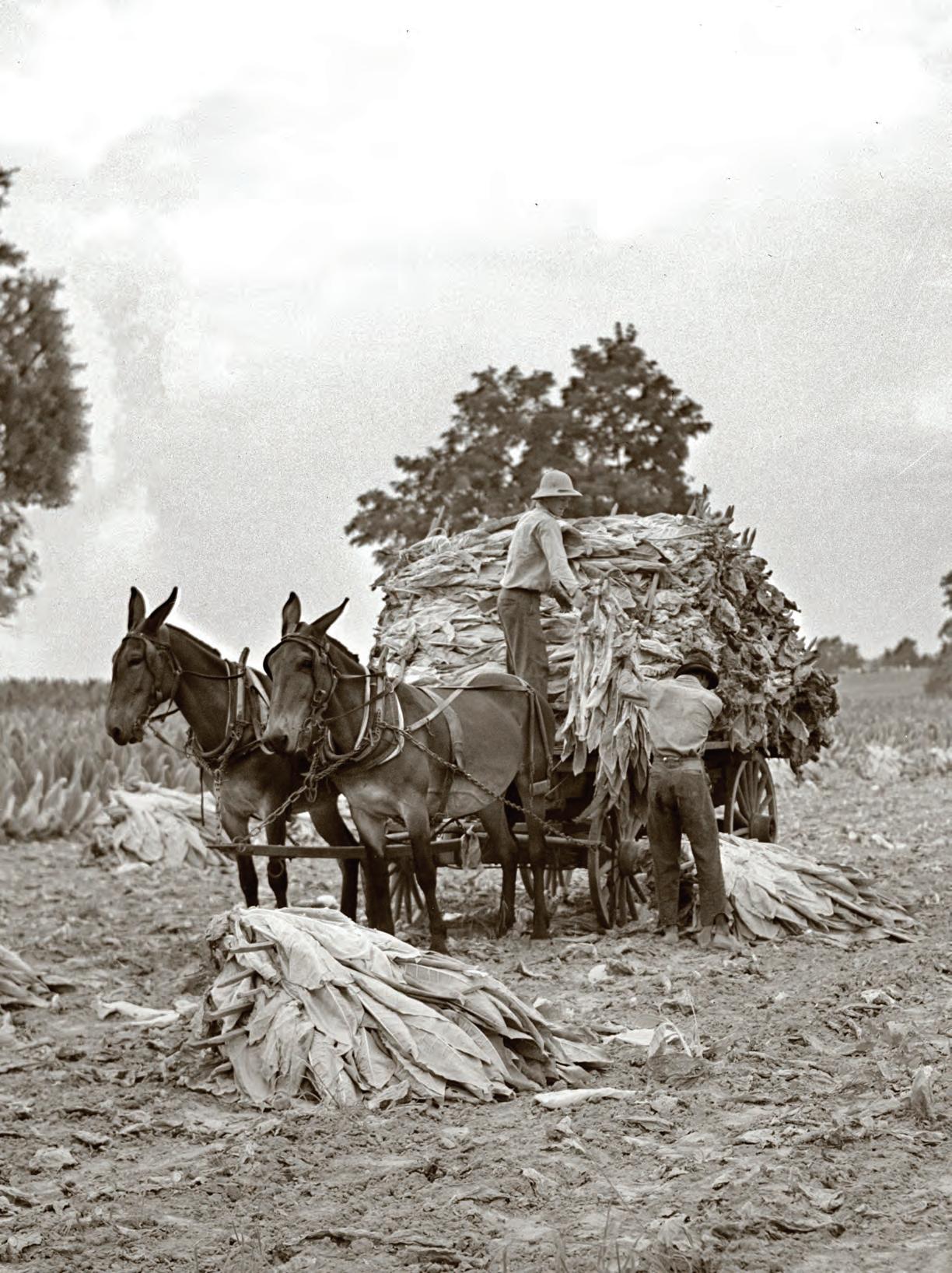
with Kentucky Explorer


with Kentucky Explorer
at the Frazier History Museum through Nov. 9 Three Photographic Surveys Exhibit

Loading cut tobacco to take to the barn, Fayette County, 1940. Marion Post Wolcott photo from Documenting Kentucky: Three Photographic Surveys.

14 Moments in History
A photographic exhibit displays scenes from the lives of everyday Kentuckians over more than 80 years
20 Towards Freedom A new Lexington monument honors Lewis and Harriet Hayden, who escaped slavery and returned to the U.S. to serve as conductors on the Underground Railroad
26 Access to the Sacred Kentucky’s new poet laureate aims to promote the virtues of creativity and connect the Commonwealth’s current and emerging artists
28 Off the Beaten Path Visit these hidden-gem Kentucky towns

34 Care, Compassion and Competence Kentucky’s 121 nursing programs train students to make a difference in the lives of their patients
38 Connecting With the Community For 60 years, Morehead State University’s WMKY-FM has served listeners in Eastern Kentucky
42 Food Fixtures Three Hodgenville eateries offer classic country cooking
Test your knowledge of our beloved Commonwealth. To find out how you fared, see page 4.
1. The Battle of Richmond, which took place Aug. 29-30, 1862, was considered a solid Confederate victory. Of the major players in the battle, who was born and raised in Kentucky?
A. Confederate Gen.
Edmund Kirby Smith
B. Union Maj. Gen. William “Bull” Nelson
C. Brig. Gen. Stand Watie
2. Grammy Award-winning country music singer-songwriter Chris Stapleton graduated from Johnson Central High School in Paintsville. A football player, he was noted with which honor at graduation?
A. Most Likely to Succeed
B. Class Clown
C. Valedictorian
3. The 260-mile Kentucky River is formed by the confluence of the North, Middle and South Forks near Beattyville in Lee County and empties into the Ohio River at which city?
A. Warsaw
B. Carrollton
C. Milton
4. Beattyville resident Malcolm MacGregor “Mac” Kilduff Jr. (1927-2003) was the acting press secretary who announced the death of which dignitary?
A. Civil rights leader
Martin Luther King
B. Presidential candidate Robert F. Kennedy
C. President John F. Kennedy
5. Owsley County native Earle Combs was the leadoff hitter on what legendary baseball team?
A. “The Hitless Wonders,” the 1906 Chicago White Sox, who shocked the 116-game-winning crosstown Cubs in the World Series
B. The 1919 “Black Sox,” whose players included eight who were found to have thrown the World Series to the Cincinnati Reds
C. The 1927 New York Yankees, led by Babe Ruth and Lou Gehrig, which for decades was regarded as the greatest team of all time
6. Lindsey Wilson University in Columbia originally was a feeder school for which Southeastern Conference school?
A. Vanderbilt University
B. Auburn University
C. Georgia Tech
7. Randy Brooks—a nephew of the Lovable Lush, Louisville-born Foster Brooks—wrote which popular Christmas song?
A. “Now Christmas Is Going to Stink for Me”
B. “Grandma Got Run Over by a Reindeer”
C. “Rudolph the Redneck Cowboy”
8. It’s ironic that Kennedy Center honoree Irene Dunne is remembered for her part in Showboat (1936) because her father, Joseph, worked in which field?
A. Vaudeville performer
B. Steamboat captain and engineer
C. Lockmaster
9. Once an administrator at the Southern Baptist Theological Seminary in Louisville, Grady Nutt was best known for his three-year stint on which popular television show?
A. The Smothers Brothers Comedy Hour
B. The Tonight Show with Johnny Carson
C. Hee Haw
10. Famous madam Belle Brezing’s first “disorderly house” was once the home of whom?
A. Elizabeth Shatner (the wife of William Shatner)
B. Laura Bell Bundy
C. Mary Todd Lincoln

© 2025, VESTED INTEREST PUBLICATIONS
VOLUME TWENTY-EIGHT, ISSUE 6, AUGUST 2025
Stephen M. Vest Publisher + Editor-in-Chief
Patricia Ranft Associate Editor
Rebecca Redding Creative Director
Deborah Kohl Kremer Assistant Editor
Ted Sloan Contributing Editor
Cait A. Smith Copy Editor
Jackie Hollenkamp Bentley, Jack Brammer, Bill Ellis, Steve Flairty, Gary Garth, Jessie Hendrix-Inman, Mick Jeffries, Kim Kobersmith, Brigitte Prather, Walt Reichert, Tracey Teo, Janine Washle and Gary P. West
AND CIRCULATION
Barbara Kay Vest Business Manager
Katherine King Circulation Assistant
Lindsey Collins Senior Account Executive and Coordinator
Kelley Burchell Account Executive
Kristina Dahl Account Executive
Hal Moss Account Executive
Laura Ray Account Executive
Teresa Revlett Account Executive
For advertising information, call 888.329.0053 or 502.227.0053
KENTUCKY MONTHLY (ISSN 1542-0507) is published 10 times per year (monthly with combined December/ January and June/July issues) for $25 per year by Vested Interest Publications, Inc., 100 Consumer Lane, Frankfort, KY 40601. Periodicals Postage Paid at Frankfort, KY and at additional mailing offices.
POSTMASTER: Send address changes to KENTUCKY MONTHLY, P.O. Box 559, Frankfort, KY 40602-0559. Vested Interest Publications: Stephen M. Vest, president; Patricia Ranft, vice president; Barbara Kay Vest, secretary/treasurer. Board of directors: James W. Adams Jr., Dr. Gene Burch, Gregory N. Carnes, Barbara and Pete Chiericozzi, Kellee Dicks, Maj. Jack E. Dixon, Mary and Michael Embry, Judy M. Harris, Jan and John Higginbotham, Frank Martin, Bill Noel, Walter B. Norris, Kasia Pater, Dr. Mary Jo Ratliff, Randy and Rebecca Sandell, Kendall Carr Shelton and Ted M. Sloan.
Kentucky Monthly invites queries but accepts no responsibility for unsolicited material; submissions will not be returned.
KENTUCKYMONTHLY.COM


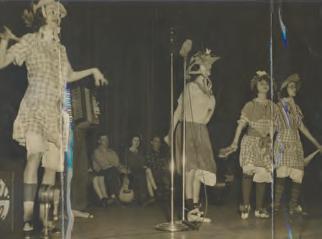
Thank you for your recent, article about Renfro Valley (March issue, page 36). One of my several talented aunts apparently performed there, circa 1943-44, as documented by the image above.
The stars of that performance were, from left, Lexingtonians Dora Lee Robertson, Larry Snedekar (partially visible, playing the accordion), Loralie Dearinger (later Howe, my aunt), Beulah McDonald and Juanita Robertson. According to my aunt’s annotation, the people in the background were part of the Renfro Valley Barn Dance Troupe, and the performance was
staged as part of the war effort for the U.S.O.
For me, it is a bittersweet image of a time when our nation was united—a time that, I fear, will not come again.
Dr. David B. Dearinger, Richmond, Virginia
All issues of Kentucky Monthly are a joy to read, but the June/July 2025 issue blew us away with the wonderful historical articles and insightful content.
Steve Vest’s “Collected Family” article for Vested Interest (page 64) was particularly touching to commemorate Father’s Day.
We had the pleasure of meeting Steve and Kay Vest a couple of years ago at a reception in downtown Louisville and were able to tour the Sons
of the American Revolution library. Every issue is greatly anticipated and never disappoints.
Thank you and your staff for such a wonderful publication.
Dave and Debbie Roberson, Nashville, Tennessee
I just finished reading Steve Vest’s recent Vested Interest, “Collected Family.” Love it! The article says so much about him. After fighting two bouts of breast cancer, I know we don’t have a guaranteed tomorrow. I live every day to make sure those I love will always know how much I cherish them. My goal is to leave a legacy of love for my “family” and to people I come in contact with.
Thank you for telling us about your “family.”
Sandy Ramsey, Pikeville
We Love to Hear from You! Kentucky Monthly welcomes letters from all readers. Email us your comments at editor@kentuckymonthly.com, send a letter through our website at kentuckymonthly.com, or message us on Facebook. Letters may be edited for clarification and brevity.



Even when you’re far away, you can take the spirit of your Kentucky home with you. And when you do, we want to see it!
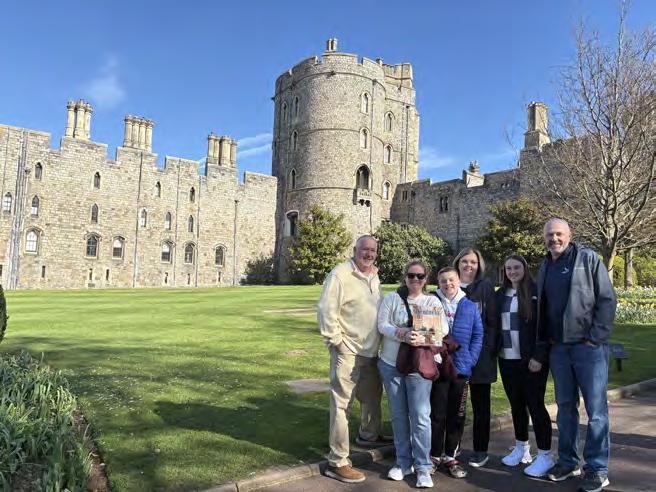

Nancy Gall-Clayton and her husband Jan C. Morris, who live in Jeffersonville, Indiana, are pictured vacationing in Iceland.
The James and Janet McClain family of Madisonville visited iconic Windsor Castle. From left, James McClain, daughter-in-law Rhea Ashby, grandson Paul Ashby, Janet McClain, granddaughter Elizabeth Ashby and oldest son Joey Ashby
Louisville residents Nancy and Craig Schroeder traveled on a European river cruise from Amsterdam to Budapest. They are pictured with cruise friends Helen, Barbara, Denise and Don in Budapest.
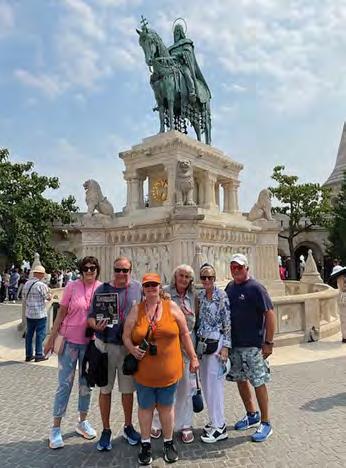
KWIZ ANSWERS 1. B. Nelson was born in Maysville and murdered in Louisville; 2. C. Stapleton was top of his class and originally went to Nashville to study engineering at Vanderbilt; 3. B. Carrollton is known as the town “where rivers and people meet”; 4. C. Kilduff was in Dallas with JFK; 5. C. Combs hit a career-high .356 and led the majors with 23 triples in 1927; 6. A. Vanderbilt from 1904-1914; 7. B. Sung by Lexington native Elmo Shropshire (known as Dr. Elmo), the song was inspired by a “tipsy” member of the Brooks family; 8. B. He was captain of a steamboat much like The Cotton Palace that Irene’s family owns in the musical; 9. C. Nutt joined the regular cast in 1979, where he improvised most, if not all, of his lines; 10. C. Oddly enough, it was the home of Abraham Lincoln’s First Lady.

Arts Change Lives.” That’s the message on one of Kentucky’s newest specialty license plates.
The plate is sponsored by Kentuckians for the Arts, the Commonwealth’s arts advocacy and education organization. Funds raised through the purchase of the plate will be used to further KFTA’s mission of informing and educating about the impact and value of the arts.

The arts also are key to a thriving economy. Kentucky’s creative sector, encompassing arts of all disciplines, is a $6.9 billion industry representing 2.5 percent of the state’s GDP. The total compensation for the more than 51,000 jobs in the sector is more than $3.3 billion and represents 2.4 percent of the state’s workforce.
“The arts are vital to Kentucky’s heritage, economy and community life,” said Lori Meadows, chair of the KFTA board. “Our organization is made up of arts supporters from across the state who want to show their passion for the arts and help get the message out that the arts benefit Kentuckians in many ways.”
Arts strengthen communities socially, educationally and economically and are vital to many sectors of the Commonwealth, Meadows noted. “Participation in the arts contributes to greater social engagement, reducing isolation and strengthening mental health and well-being. The arts are critical to a well-rounded education, and academic performance is improved by involvement in the arts.”
In addition, the arts drive tourism across Kentucky, with arts travelers staying longer and spending more to seek out authentic cultural experiences.
Policies and funding that are supportive of the arts are necessary to maintain and grow Kentucky’s creative economy, Meadows added.
So far, more than 1,200 Kentuckians display the new license plate. “We hope Kentuckians in every county will see these plates on the road as a reminder that the arts benefit us all,” Meadows said.
Those wanting to demonstrate their support for the arts can purchase a plate at Drive.Ky.Gov or at their local County Clerk’s office.
For more information about Kentuckians for the Arts, visit kyforthearts.org
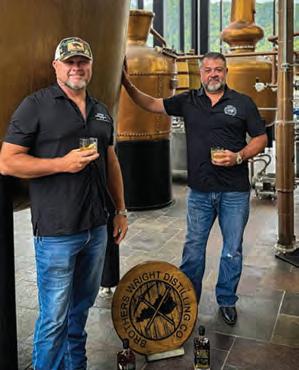
Brothers Wright Distilling Co. announced its acquisition of Dueling Barrels Brewery & Distillery, Pearse’s Place restaurant, welcome center and tasting room in downtown Pikeville. This marks a large expansion and investment for Brothers Wright Distilling in the region’s economy and the state’s already rich distilling industry. The 30,000-plus-squarefoot facility previously was owned and operated
by Alltech’s Lyons Brewing & Distilling Co.
“This acquisition represents more than just an expansion of our operations—it’s a deepening of our investment in Pikeville, Pike County, and the future of Eastern Kentucky,” said Shannon Wright, co-founder of Brothers Wright Distilling Co.
Dueling Barrels originally was envisioned by the late Dr. Pearse Lyons and his wife, Deirdre, co-founders of Alltech, who saw the Appalachian region’s landscape, people and rich traditions as reminiscent of their Irish heritage.
“We are honored to carry forward the vision the Lyons family brought to life in Pikeville,” said Kendall Wright, co-founder of Brothers Wright Distilling Co. “Dueling Barrels has become a symbol of pride for the community, and we’re excited to build on that legacy—infusing new energy and experiences while preserving the spirit and story that make this place so special.”
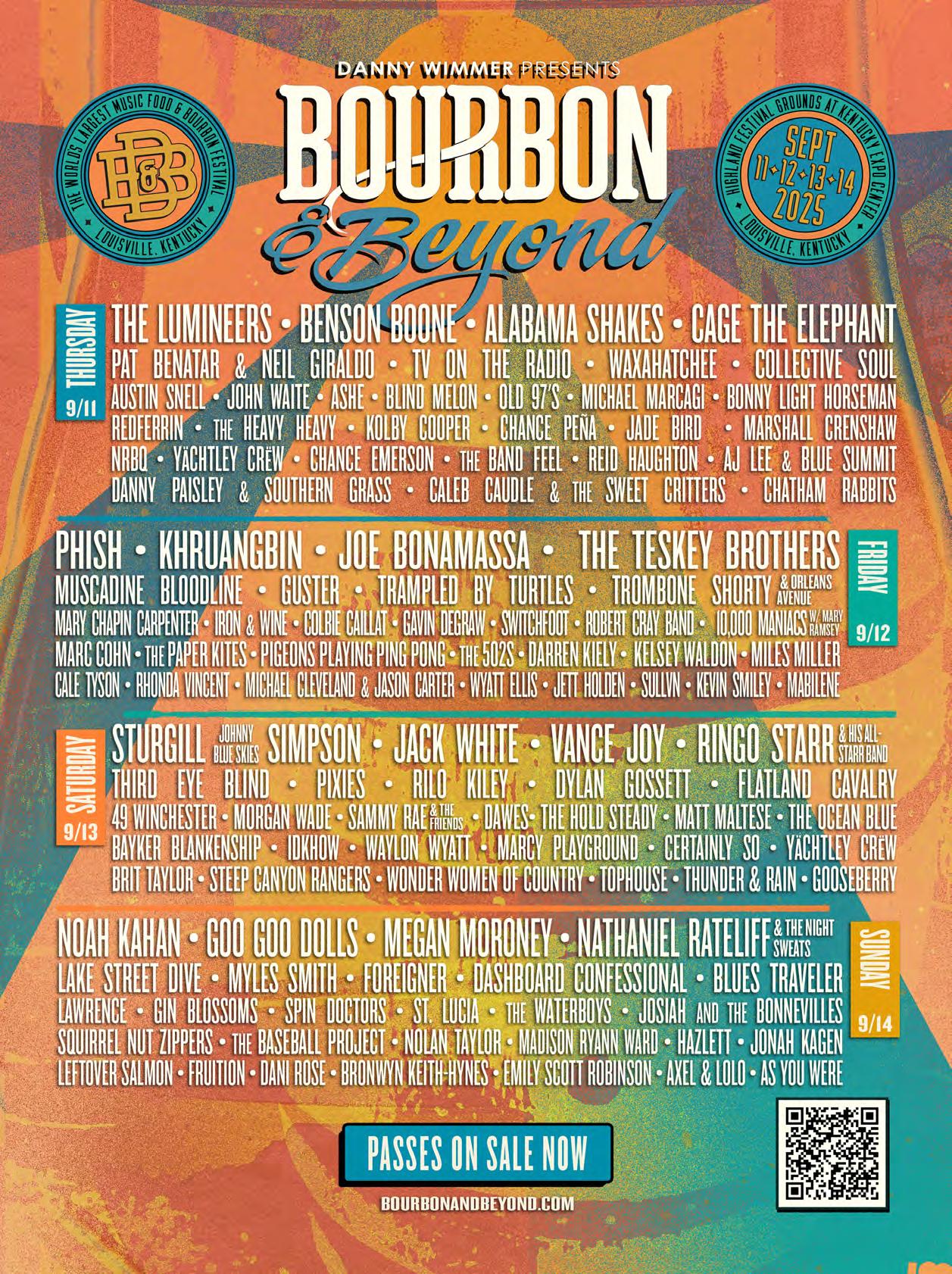
BY LAURA YOUNKIN
Taylor Hughes has a lot going on. A country music artist and songwriter living in Nashville, she’s a Lexington native who has nurtured her musical career in Music City for 12 years. Now, she is nurturing her newborn daughter, Kennedy, who came into the world July 1. Hughes hopes her daughter inherits her musical talent.
“I came out of the womb singing,” Hughes said. She also was an athletic girl, and volleyball was her joy. While in high school, she planned to attend college on a volleyball scholarship. Unfortunately, a severe knee injury her junior year ended that dream.
When Hughes asked her parents for guitar lessons, they thought learning guitar was a great idea. What they didn’t realize was how talented she was. After a handful of lessons, her guitar teacher invited her to sing in Nashville on the Comcast TV show Nashville Spotlight, a local broadcast produced quarterly at the Nashville Palace. She was so well-received at her debut that she became a regular.
Hughes’ parents were surprised. “They asked, ‘Was that actually you singing?’ ” she said. Hughes had a new dream—music.
“I started playing bars and venues around Lexington as soon as I was old enough to get in them,” Hughes said. She met her future husband, Drew Noble, in Lexington. The two married in 2017 and moved to Nashville.
“I was born, raised and lived [in Lexington] for 25 years before we moved to Nashville,” she said. “I’m very much to my core a Kentuckian.”
In case anyone questions her credentials, “Basketball is my
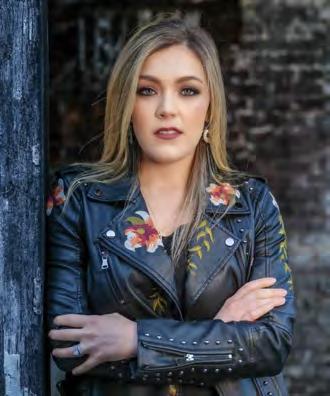
religion,” she said.
Kentucky musicians have influenced Hughes’ music, with one of her biggest influences being Johnson County native Chris Stapleton. She admires how he blends soul and country. Hughes also likes Ashlandborn Wynonna Judd and her bluesy, gutsy country sound. “The Judds influenced a lot of women in music,” she said.
“I love Carly Pearce. I’m a huge fan … She’s so vulnerable,” Hughes said of the Taylor Mill artist. Hughes appreciates Pearce’s openness about her emotional states in her songs.
“Country music is a boys’ club, but my voice is a lot deeper than a lot of women,” Hughes said, and she thinks that has opened some doors for her.
“I’ve been asked on a regular basis if I was a singer in a rock band.” She wasn’t. “I’ve always been country. My husband says I’m the blues.”
Hughes blends country, blues and country-fried rock in her sound. The Tennessee Star Magazine called her “country music’s answer to Adele.”
“I never try to sound like anybody. I think that’s cool about what I bring
to the table,” she said.
Hughes said it took her a while to find her niche in Nashville, but “I’ve got a good group of girls—and guys— that I write with,” she said. “I absolutely love being here. There’s music 24/7. It’s cool being here because it’s opened my eyes to all parts of the music business.”
Hughes’ schedule has meant touring on the weekends and songwriting in Nashville during the week. “My favorite part of what I do is performing,” she said.
Hughes loves meeting fans and feeling the energy of live shows. She tries to play as many shows that support veterans and the military as possible. “I have several family members who have served,” she said.
Hughes has won Lexington Music Awards such as Country Artist of the Year in 2023 and Female Vocalist of the Year and Song of the Year for “Jesus and Jail” in 2024.
The Josie Awards, which are for the independent music industry, deemed her Multi-Genre Vocalist of the Year in 2023 and Southern Rock/ Country Rock Female Vocalist of the Year in 2024. Hughes is a nominee for three more Josies this year.
Even as she enters a new phase of her life—motherhood—Hughes plans to continue her music career. “I have no plans of stopping,” she said.” This is what I live and breathe and eat. I can’t imagine not doing it.
“I want my daughter to grow up and see her mom chase her dreams.”
For more information on Taylor Hughes, go to taylorhughesmusic.com. You can also find her on Facebook, Instagram and YouTube.

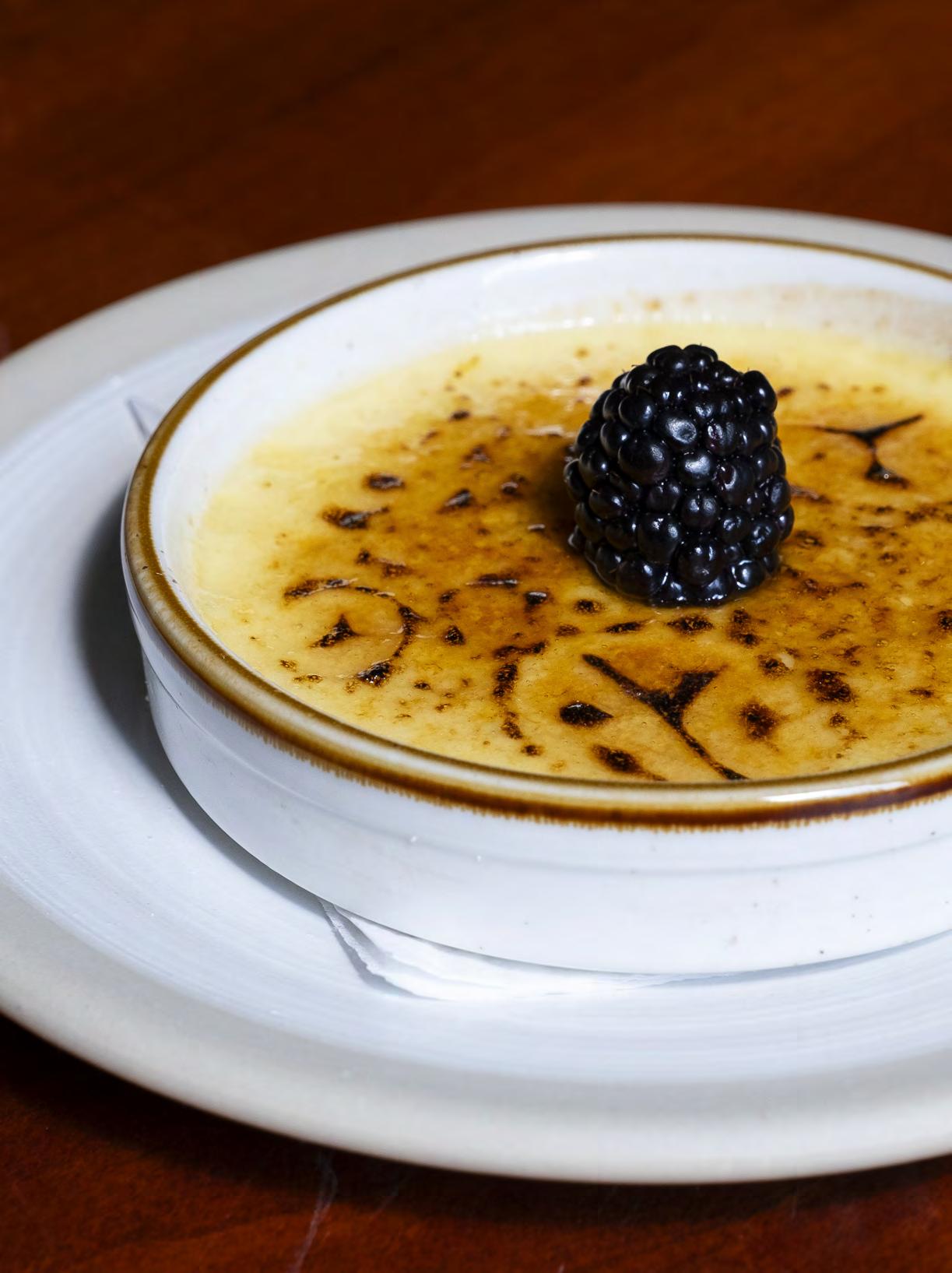
Steeped in tradition, The Trustees’ Table at Shaker Villag e in Harrodsburg has been “making you kindly welcome” since 1968. Today, Executive Chef Amber Hokams and Farm Manager H.P. Lovelace collaborate to bring the freshest food to guests every season. The menu recently was reimagined with a return to family-style dining. Each day brings a rotating selection of straight-from-the-garden side dishes that are shared around the table. Mainstays such as Mrs. Kremer’s fried chicken, country catfish and a 12-ounce hog chop leave diners satisfied, but you should save room for a slice of the famous Shaker lemon pie.
1 cup heavy cream
1 vanilla bean, pod scraped
3 egg yolks
¼ cup granulated sugar
2 teaspoons Maker’s Mark bourbon
1/8 teaspoon salt
Granulated sugar
1. Preheat oven to 325 degrees.
2. Over medium heat, simmer cream and vanilla bean in a saucepan.
3. In a bowl, whisk together egg yolks, bourbon and salt. Slowly whisk cream mixture into egg mixture and mix until combined.
4. Fill ramekins with mixture almost to the top and place ramekins in a deep-sided baking pan. Pour hot water around ramekins until water is halfway up the side of the ramekins.
5. Bake until the mixture has set, about 30 minutes.
6. Remove ramekins from the baking pan and transfer to a cooling rack. When cool, transfer ramekins to the refrigerator and chill overnight or 4-5 hours.
7. To serve, sprinkle a thin layer of granulated sugar on tops of ramekins. Using a kitchen torch, caramelize the sugar until it’s brown and will achieve the signature snap of a crème brûlée when tapped with a spoon.
Trained at Le Cordon Bleu College of Culinary Arts in Austin, Texas, Chef Amber has led the culinary team at Shaker Village since 2018. Using the bounty delivered from the farm and the certified-organic Shaker Garden, her menus highlight seasonal produce, allowing for a unique dining experience each time you pull up a chair at The Trustees’ Table.
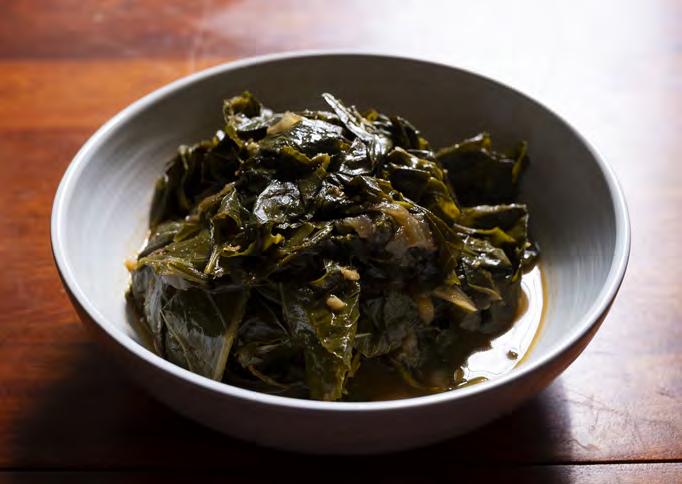

Recipes and photos courtesy of Shaker Village of Pleasant Hill.
¼ pound butter
¼ cup bacon grease
1 sweet onion, thinly sliced
2 tablespoons garlic, minced
2 tablespoons ancho chile powder
5 pounds lacinato kale, stems removed, washed and spun dry
2 quarts homemade chicken stock
½ cup apple cider vinegar
½ cup light brown sugar
1. Melt butter and bacon grease over medium heat in a large pot. Sauté onions until golden.
2. Add garlic and ancho chile powder. Cook until garlic is fragrant, about 30 seconds.
3. Add remaining ingredients to pot. Cover with a lid until chicken stock comes to a boil, then turn heat to medium-low.
4. Allow to simmer until kale is tender.

YIELDS 10-12 CAKES
2 eggs
1 cup buttermilk
¼ cup water
¼ cup butter, melted
2 ears corn, roasted and removed from cob
2 tablespoons scallions, thinly sliced
1 cup flour
1 cup cornmeal
1½ teaspoons baking powder
¼ cup sugar
2 teaspoons salt
1 teaspoon smoked paprika
1 teaspoon garlic powder
Butter to cook
Basil-Lime Crema, recipe follows
Sauteed okra, tomatoes and zucchini
1. In a large bowl, whisk together eggs, buttermilk, water, melted butter, corn and scallions.
2. In a separate bowl, combine flour, cornmeal, baking powder, sugar, salt, paprika and garlic powder.
3. With a spatula, gently fold dry mixture into wet mixture.
4. Heat a large sauté pan or griddle over medium-high heat. Add butter, using a trigger scoop, and add johnny cakes to the pan.
5. Cook 2-3 minutes per side.
6. Finish with basil-lime crema and sauteed okra, tomatoes and zucchini.
BASIL-LIME CREMA
½ cup fresh basil, picked and roughly chopped
1 tablespoon lime juice
1 cup sour cream
¼ teaspoon ground cayenne pepper
¼ teaspoon kosher salt
¼ teaspoon black pepper
¼ teaspoon garlic, minced
Add all ingredients to a food processor and blend to combine well.
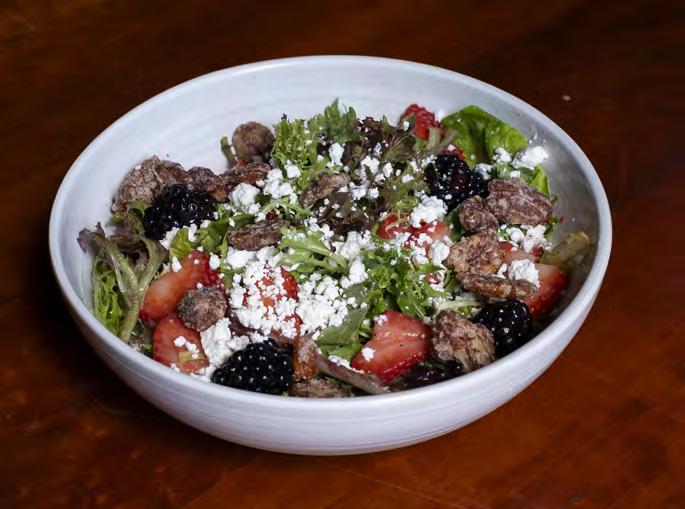
½ cup champagne vinegar
¾ cup Shaker Village honey
½ cup lemon juice, freshly squeezed
1 cup avocado oil
1 teaspoon kosher salt
1 teaspoon whole grain mustard
2 teaspoons poppy seeds
2 cups local spring salad mix
Sliced strawberries, blackberries, crumbled goat cheese and candied pecans to finish
1. Add first six ingredients to a blender and blend well to combine.
2. Add poppy seeds.
3. Add local spring mix to a large bowl, pour ¼ cup dressing over lettuce, and toss to combine.
4. Finish with strawberries, blackberries, crumbled goat cheese and candied pecans.
plan your trip
The Trustees’ Table
Shaker Village of Pleasant Hill
3501 Lexington Road, Harrodsburg
To view The Trustees’ Table menu and make a reservation, visit shakervillageky.org or call 859.734.5411.

¼ cup salted butter
8 ears of corn, roasted and removed from the cob
2 cups garden cherry tomatoes, halved
2 cups garden bell pepper, diced
1 cup fava beans (can substitute lima beans if fava beans are unavailable)
2 tablespoons fresh garlic, minced
¼ cup fresh basil, chiffonade
¼ cup green onions, thinly sliced
2 limes, zested and juiced
Salt and pepper, to taste
1. Over medium heat, add butter to a large sauté pan. Once butter has melted, add corn, cherry tomatoes and bell peppers. Sauté until peppers are tender.
2. Add fava beans and garlic. Sauté until fava beans are warmed.
3. Finish with basil, green onions and lime zest and juice.
4. Season with salt and pepper to your liking.


“Life isn’t a matter of milestones but moments.” Rose Kennedy

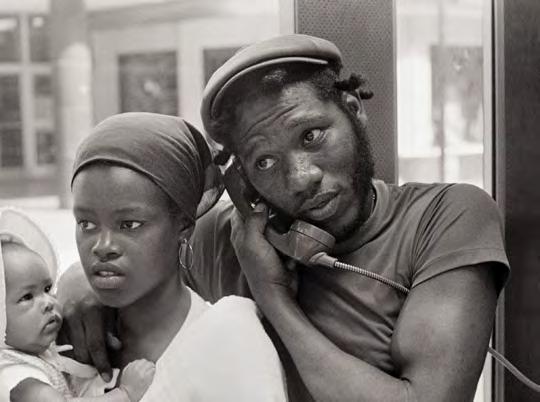

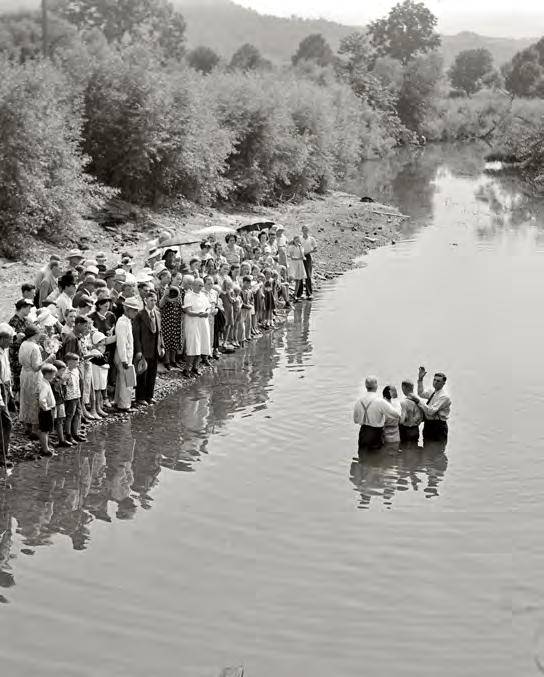

A photographic exhibit displays scenes from the lives of everyday Kentuckians over more than 80 years
BY JACKIE HOLLENKAMP BENTLEY

Across 2,000 square feet on the third floor of the Frazier History Museum in Louisville, roughly 150 photographs capture moments from three different eras in Kentucky that span nearly 100 years.
In one moment, it’s 1940 at the Shelby County Fair dirt track, where a dapper young man sporting wingtip shoes and a snazzy hat judges the health of a row of plump babies sitting comfortably in the laps of their well-dressed mamas.
Fast forward 76 years to the 2016 Shelby County Fair. Little Miss and Little Mister Shelby County sit next to the dirt track. He’s sporting shorts, flip-flops and an oversized crown. She is pretty in pink with a sparkling tiara.
Another moment portrays a couple getting baptized in a Morehead creek during the Great Depression. Roughly 80 years after that, a Leslie County woman rises from her baptismal submersion in a Hyden lake.
Standing alone in a 1977 moment is a young man using a payphone, his wife and baby hugged to his side.
•
All of these can be seen at the Frazier’s latest exhibit, Documenting Kentucky: Three Photographic Surveys, open through Nov. 9. “It’s so valuable for us to have here at the Frazier,” said Amanda Briede, the senior curator of exhibitions. “Not only does [the exhibit] represent all of Kentucky’s counties, it also shows the history of Kentucky and being able to visually see that history from all over the state. It’s really showing such a breadth of time and space and really what Kentucky is, and it’s such a beautiful exhibition.”
In the throes of the Great Depression, the National Farm Security Administration commissioned photographers to visually document rural America. The images, many taken in poverty-stricken rural Kentucky, were then used in newsreels and publications across the country.
• • •
In 1975, Louisville photographer Ted Wathen had the

idea to solely document Kentucky by capturing moments in every county in the Commonwealth. He brought on fellow photographers Bob Hower and Bill Burke, thanks to a small grant from the National Endowment for the Arts, for the Kentucky Documentary Photographic Project (KDPP).
Their work was exhibited at the Speed Museum in Louisville; the George Eastman House and International Museum of Photography and Film in Rochester, New York; and, ultimately, the Smithsonian American Art Museum.
“Then it lay dormant for 30 years,” Wathen said. “We revived it at the Frazier in 2011, and the response to that show was just overwhelming. People kept saying you need to do it again; you need to do it again. So, we did it. We started it again.”
In 2014, the KDPP was reborn with a new grant from the National Endowment for the Arts, a grant from the Kentucky Arts Council, and contributions from multiple donors.
Past and present— opposite page, plump baby contestants are judged at the 1940 Shelby County Fair; this page, pictured with their royal trappings, Little Miss and Little Mister Shelby County relax at the 2016 county fair.
Wathen said they went from three “upper-middle-class white guys with graduate degrees” in the 1970s, to more than two dozen photographers—many coming from different countries asking to be a part of something special, even if the pay wasn’t spectacular.
“It’s not generous. It wasn’t as much as they would make doing commercial work,” Wathen said. “But if you talk to them, they’ll all say this is the best thing they ever did.”
Arkansas photographer Rachel Boillot confirmed that in a blog post on KDPP’s website, kydocphoto.com
“As a member of the KDPP team, it is my great honor to record our present in order to contribute to this canon of visual history that I so revere,” she wrote. “It is this very conviction that keeps me going.”
Wathen said more than 200,000 photos were taken during the two periods, and they all weave a story of moments of stark change between 1975 and today.
“People ask the question, ‘What’s the difference between the ’70s and the project you see now?’ ” Wathen said. “If you were gay, you were in the closet … In the ’70s, I never saw

More information about the Kentucky Documentary Photographic Project can be found on its website at kydocphoto.com.
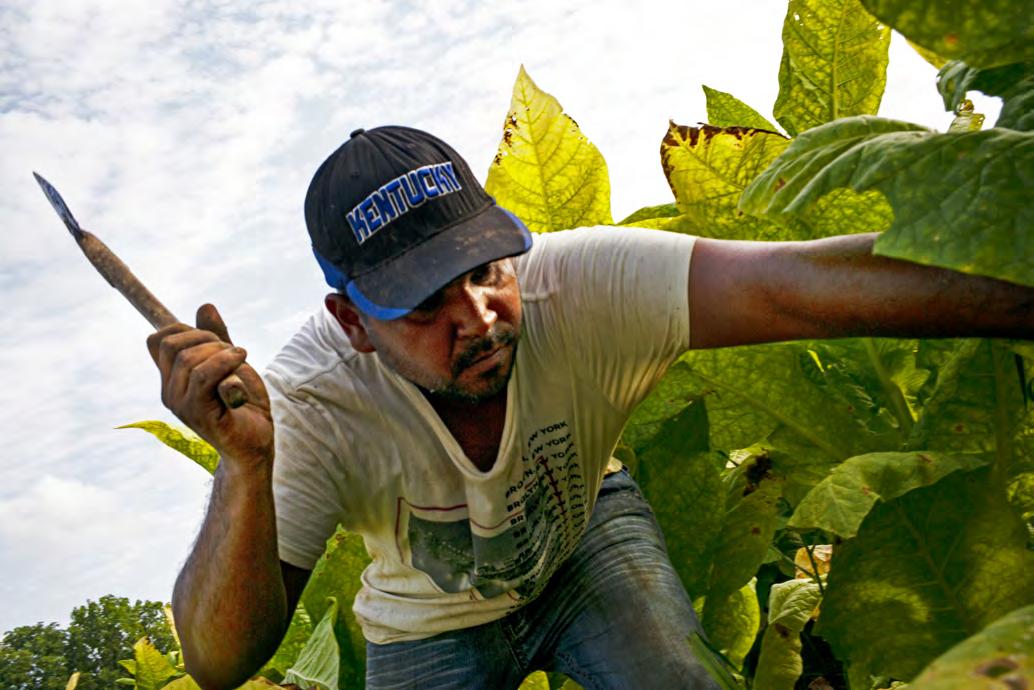
an interracial couple. Nobody was walking around with these little devices in their hands all the time.”
Wathen noted that even the demographics have changed.
“You drive through rural Kentucky now, and you see tobacco barns falling down all over the place. And because the small farms have disappeared, land prices in Kentucky are cheap,” he said. “So, the Mennonites have moved in. The Amish have moved in. In the 1970s, I never saw any Amish.”
The photos will be turned over to the University of
Louisville Photographic Archives once the exhibit ends in November.
The photos from the National Farm Security Administration’s Great Depression project are now preserved in the Library of Congress and available for public use.
Wathen said Kentucky’s moments of history are never over. “We would like some members of the current crop of photographers to take up the mantle and start the project anew in 2055, thus keeping the 40-year cycle intact,” he said. Q
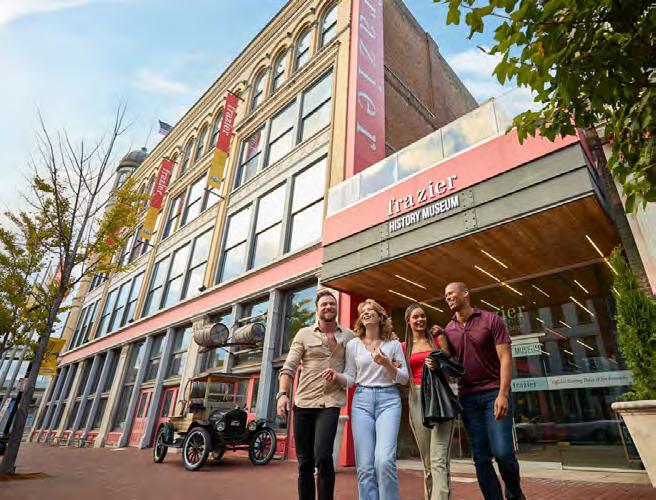
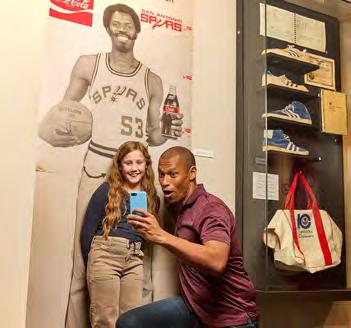
Frazier History Museum
829 West Main Street, Louisville
502.753.5663
Monday-Saturday 10 a.m.-5 p.m.
Sunday 11 a.m.-4 p.m.
The exhibition will be on view through Nov. 9, 2025, and will include a series of public programs, including a collaboration with Louisville’s Photo Biennial.
Through nearly 150 photographs, visitors will gain new insight into the everyday lives of Kentuckians—how they lived, worked, celebrated and endured across decades of cultural and economic change.
“The stories these images tell—some stark, some joyful, all deeply human—remind us of the power of photography to record and reflect a place and its people,” Frazier Senior Curator of Exhibitions Amanda Briede said. “This exhibition is not just about Kentucky’s past. It’s also a mirror held up to its present and a conversation about its future.”

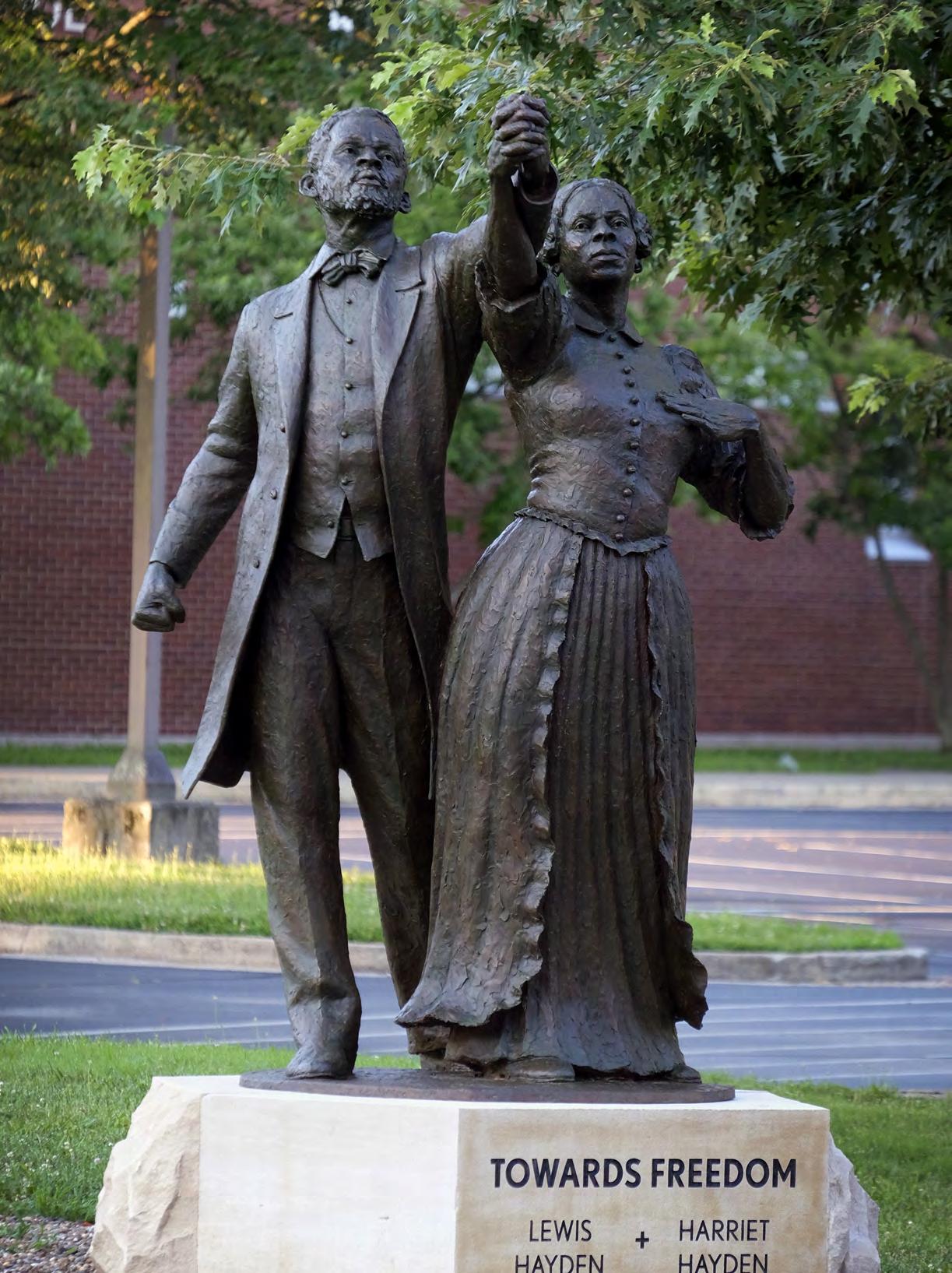
A new Lexington monument honors Lewis and Harriet Hayden, who escaped slavery and returned to the U.S. to serve as conductors on the Underground Railroad
STORY AND PHOTOS BY TOM EBLEN
Like many Southern cities, Lexington has removed century-old Confederate monuments from its public spaces in recent years. Bronze statues of Generals John Hunt Morgan and John C. Breckinridge were relocated in 2017 from the old courthouse square to Lexington Cemetery, where both men are buried. But last month, a new bronze statue was erected to honor two Lexington heroes from the other side of America’s fight over slavery. Their lives were amazing, and the grassroots effort to honor them is a good story, too.
Nearly 500 people crowded Lexington Traditional Magnet School’s lawn at the corner of North Limestone and Fourth streets on June 19 as a larger-than-life statue of Lewis and Harriet Hayden was unveiled. The couple escaped slavery in Lexington in 1844 and resettled in
Boston, where they became influential leaders in the Underground Railroad and abolitionist movement. The statue, by acclaimed Jamaican sculptor Basil Watson and titled “Towards Freedom,” depicts the Haydens striding north together, arms raised and hands clasped.
“It’s fitting that we’re unveiling this statue on Juneteenth, a day when we stand united in acknowledging our past and our nation’s greatest injustice,” Gov. Andy Beshear told the crowd. “We stand here with a recognition that there is still more progress to be made.”
Lewis Hayden was born in in 1814 in the block across North Limestone from the statue. He was enslaved to Presbyterian minister Adam Rankin. At 10, he was traded

to a cabinetmaker for a pair of horses, then had a series of masters. Hayden married an enslaved woman named Esther, and they had a son. But in a widely published letter in 1847, he wrote that statesman Henry Clay sold his wife and child, and he never saw them again. (Clay denied that.) Hayden later married Harriet Bell, who—with her son, Joseph—was enslaved to the owner of a Lexington hat factory.
In 1844, Lewis Hayden was owned by two businessmen who rented him out to the Phoenix Hotel, where he was a waiter. He met two abolitionists: Methodist minister Calvin Fairbank, a native of western New York, and Delia Webster, a schoolteacher from Vermont. On an October evening, Fairbank and Webster rented a carriage and spirited Lewis, Harriet and Joseph out of town. The Underground Railroad smuggled the Haydens to Canada, but they soon moved to Boston to join the fight against slavery. Lewis Hayden became a prominent speaker and activist. The Haydens used their home as a boardinghouse for escaped slaves, and Lewis let it be known that the cellar was packed with gunpowder in case any slavecatchers tried to storm the place.
Fairbank and Webster were less fortunate. They
returned to Lexington, where they were arrested and sent to prison. Gov. William Owsley pardoned Webster two months into her two-year sentence. Fairbank served five years at hard labor until Hayden won his release by raising $650 to compensate his former enslavers.
Hayden, who ran a Boston clothing store to support his activism, became more radical after the passage of the 1850 Fugitive Slave Act, which required people in free states to help return runaways. He helped organize a mob that sprung a captured runaway from a Boston jail, and he worked with abolitionist John Brown to raise money for his unsuccessful raid on the federal arsenal at Harper’s Ferry in 1859.
During the Civil War, Hayden convinced Massachusetts Gov. John Andrew to persuade President Abraham Lincoln to allow Black men to fight in the Union Army. Hayden was instrumental in organizing the 54th Massachusetts Volunteer Infantry, whose story was told in the Oscar-winning 1989 movie Glory
Hayden later served in the Massachusetts legislature. When he died in 1889, the New York Age newspaper described Hayden as “easily the most prominent colored
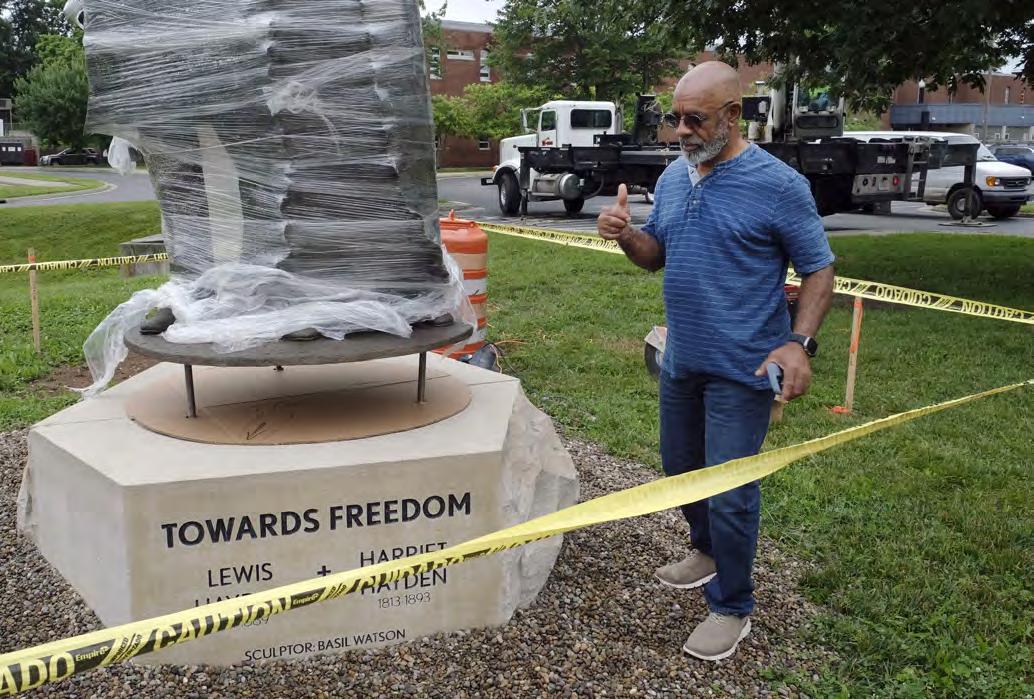
man in New England.”
Harriet Hayden became as well-known as her husband. After the Civil War, she was active in the temperance and women’s suffrage movements, and she organized Black Bostonians’ celebration of the nation’s centennial in 1876. When she died in 1893, she left Harvard University $5,000 to create scholarships for Black medical students.
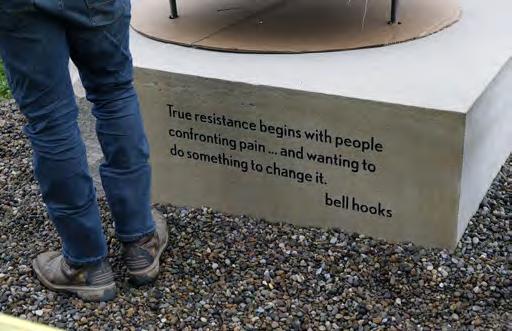
The Haydens were largely forgotten in Lexington until two books were published in the late 1990s: Delia Webster and the Underground Railroad by Randolph Runyon (1996) and Lewis Hayden and the War Against Slavery by Joel Strangis (1999). The Haydens were just two of many examples of Black people in Kentucky who accomplished great things despite oppression before civil rights laws were passed in the 1960s.
• • •
Researching and telling those stories has become a second career for Yvonne Giles, a retired home extension
Above, sculptor Basil Watson gave a thumbs up to approve the positioning of his statue on its stone pedestal, which includes a quote from Kentucky author bell hooks, left.
agent. Over the past 25 years, Giles has become the go-to expert on Black history in Lexington. So, it was natural that Sherry Maddock, a white East End resident, would seek Giles’ advice in 2016 when she decided the neighborhood needed to commemorate its rich Black history. Giles suggested three possibilities, but it was the Haydens’ story that captured Maddock’s imagination.
“The story of Lewis and Harriet Hayden is a perfect example of enslaved people, their aspirations, their ambition and their courage,” Giles said. “Telling their joint story was very important. Harriet was as strong if not stronger than Lewis.”
Maddock’s vision for the monument quickly attracted support, but the effort stalled after she and her family moved to her husband’s native Australia.
Below, Larry Kezele spoke at an educational program in May about the effort to erect a statue to memorialize the Haydens and educate people about Lexington’s legacy of slavery; bottom, Yvonne Giles, a researcher and expert on Black history in Lexington, posed beside “Towards Freedom.”
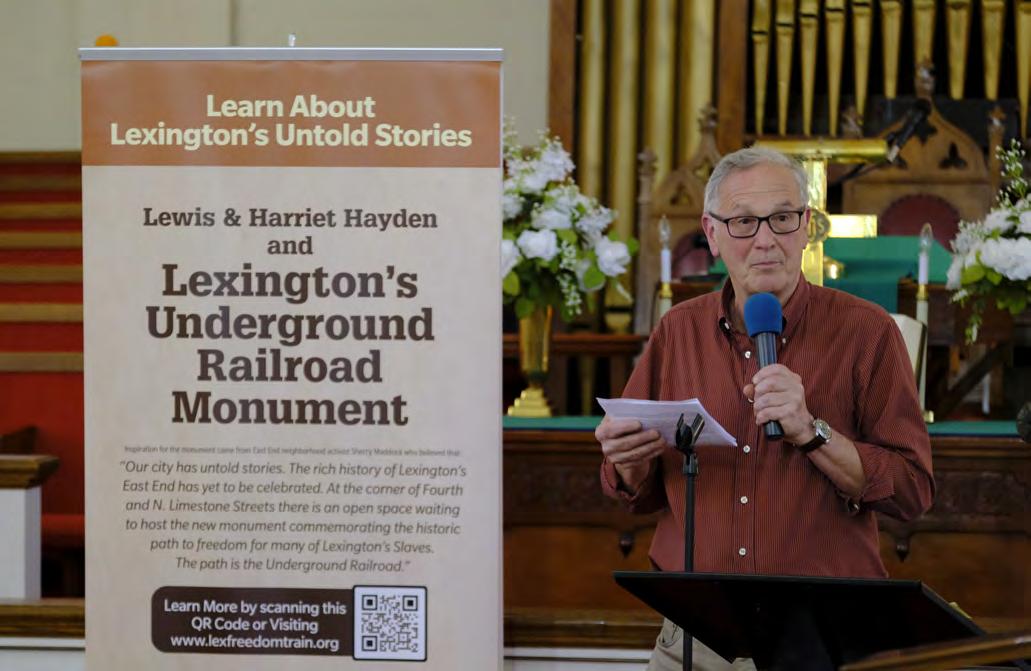
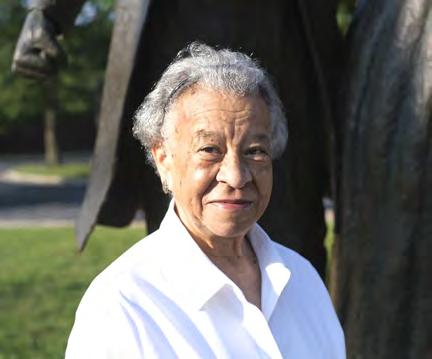
Things got going again after the COVID-19 pandemic, thanks to Giles and a group of North Limestone neighbors and interested citizens led by Larry Kezele, who for 45 years has lived in a circa 1860 house across from the statue. “It was just such a compelling story,” said neighbor Linda Carroll, who with her husband, John Morgan, restored and live in the Rankin house, where Hayden was born.
The group formed a nonprofit organization, Lexington Freedom Train (lexfreedomtrain.org), and raised $450,000 for the statue, including the largest-ever grant of $245,000 from the city’s Public Art Commission. The statue and its future maintenance are paid for, and the group is working to raise another $275,000 to combine with $150,000 it has in the bank to build an informational garden around the statue ($300,000) and fund educational curricula and programming ($125,000).
Watson, the sculptor who now works from suburban Atlanta, said one of his goals was to emphasize that the
Haydens were equal partners. “The movement toward freedom or progress is always teamwork,” he said. “They say if you want to go fast, go alone; if you want to go far, go together.”
Frank X Walker, a former Kentucky poet laureate, said being a member of the Freedom Train committee inspired him to write a poem about Lewis Hayden in his latest book, Load in Nine Times. The poem’s title comes from what Fairbank wrote that Hayden told him when he asked why he wanted his help to escape slavery: “Because I am a man.”
It was great to have the governor, the mayor, City Council members and hundreds of people turn out for the statue’s dedication, Kezele said. But what has been more gratifying has been to look out his windows and see Black families stop, admire the statue and take joyful photos of themselves mimicking Lewis and Harriet Hayden, arms raised and hands clasped. “It opens up conversations for the people of the East End,” Kezele said. “So many stories have yet to be told.” Q

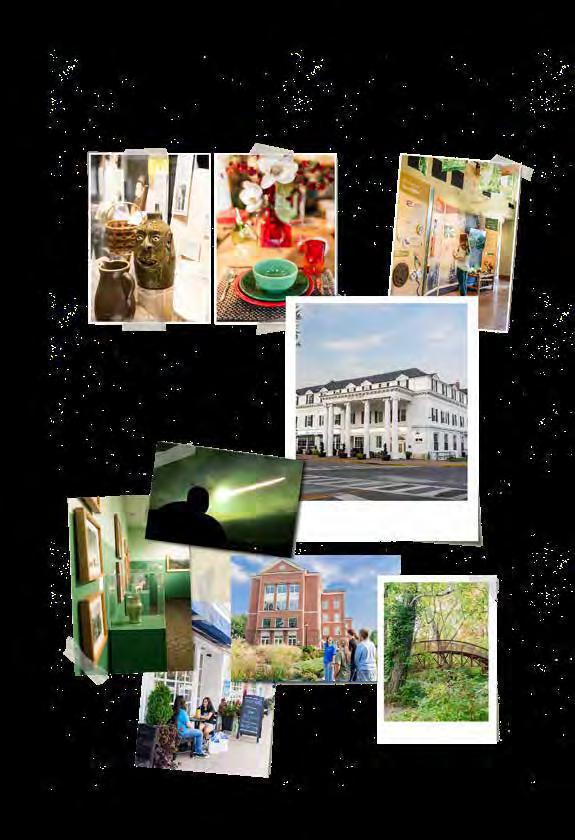







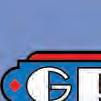

























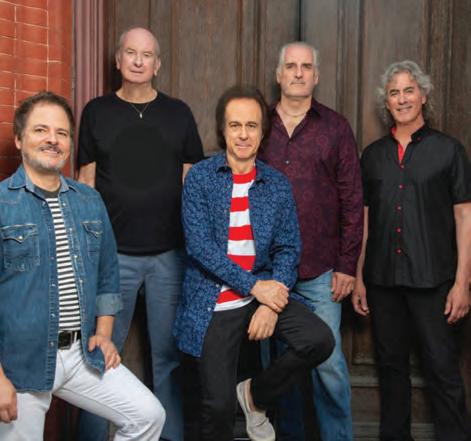




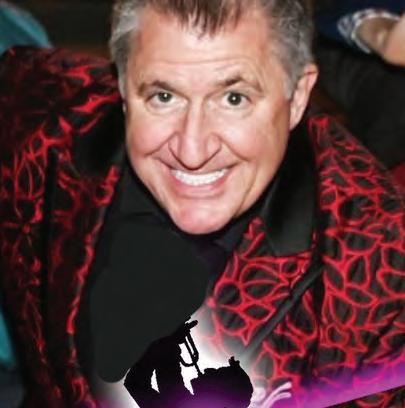


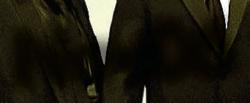
Kentucky’s new poet laureate aims to promote the virtues of creativity and connect the Commonwealth’s current and emerging artists
BY RICHARD TAYLOR
Kentucky has a new poet laureate.
Kathleen Driskell of Louisville will serve a two-year term traveling the Commonwealth to promote the literary arts, encouraging writers young and old through workshops and readings, and setting a good example for those who wish to express themselves creatively. On April 24—Kentucky Writers’ Day (the birthday of the nation’s first poet laureate, Todd County native Robert Penn Warren)—Driskell was inducted as the Commonwealth’s poet laureate in a ceremony presided over by Gov. Andy Beshear in the marble rotunda of the Kentucky State Capitol in Frankfort.
Before an assembly of former poets
laureate, state officials, lovers of Kentucky literature and the honoree’s family, the governor welcomed the new poet laureate and thanked her predecessor, novelist and poet Silas House, for his energetic performance during the past two years. In addition to Kentucky’s youth poet laureate, Maria Faisal, Driskell and House each read selections of their work under the towering statue of Kentucky’s Abraham Lincoln
Like Lincoln, Driskell grew up in a rural setting in a working-class family, her home being the Oldham County of nearly a half-century ago. She attended Murray State University and received a bachelor’s degree from the University of Louisville before earning a master of fine arts degree from the University of North Carolina
at Greensboro. She returned to Kentucky and began teaching at Spalding University’s low-residency creative writing program in Louisville, rising to the position of chair of the Naslund-Mann Graduate School of Writing at the university. Driskell’s work has appeared in publications as diverse at The New Yorker, Appalachian Review, Southern Review, Shenandoah, and many small-press magazines, and she has received many writing awards.
•
• •
Writer, teacher and arts activist
Kathleen Driskell is the author of six collections of poetry, the most recent of which is Goat-Footed Gods. Her honor as poet laureate is a natural extension of what she has been doing for years, for Driskell sees her role as making
connections among writers and audiences, promoting all the arts— especially writing—in a state nationally known for its community of writers, living and dead. The quality of writing in Kentucky, she affirmed, rivals that of any state in America: “Writers and readers are working every day across the state to support and simplify what it means to be a Kentuckian in all our shapes and colors.” Their backgrounds and approaches are as diverse as the people and places they inhabit: “hills, hollers, glades, plateaus and prairies.”
Now, much of her work relating to place centers on a once-abandoned church that she and her husband, Terry, re-habbed in a square mile outside Louisville. Central to her attention to place is her collection Next Door to the Dead, a reference to the old cemetery in which many members of the church’s congregation are buried. Following the example of Edgar Lee Masters in his Spoon River Anthology written more than l00 years ago, through imagination and fact, Driskell ingeniously recreated the lives of those interred there, including a former slave, a Civil War infantryman and a snake handler.
When asked about her vision for her two years as poet laureate, she affirmed her rootedness in Kentucky. “I want to applaud our many and diverse Kentucky writers, especially contemporary Kentucky writers, as much as I can within and outside the state,” she said. “I’m proud to say that great writing in Kentucky is thriving across all genres, from poets to screenwriters.”
Driskell shared a kind of artistic
statement of faith that might be a credo for every serious artist. “I believe when we engage our creativity, we’re being given access to the sacred, the divine,” she said. “When we activate our imaginations, we are activating our capacity to love ourselves, to love one another. We create a world that demonstrates our shared humanity is strengthened through, paradoxically, writing about the differences among us.”

Driskell’s former service as chair of the board of a national network of writers, the Association of Writers & Writing Programs, has given her a perspective on Kentucky’s place in the forum of national literature in which Kentucky writers are prominently represented. Connecting, she said, is the key, recognizing the importance of connectedness among writers, especially between experienced and emerging writers. To promote this goal, she and friends founded the Kentucky Writers Coalition when she returned to the state from graduate school 30 years ago. The organization, which eventually had 2,500 members, provided a clearinghouse to share information about writing conferences, readings and publications across Kentucky. The internet eventually became a more favorable conduit for exchanging such information and bringing writers, teachers, librarians and bookstores together.

As poet laureate, Driskell said that she wants to connect with some of the existing writing groups within the state, such as the Kentucky Poetry Society, with master classes. Energetic and plain-spoken, she also wants to work with other writers who are also teachers, concentrating on Kentucky high schools, where the next generation of Kentucky writers is formed. This may involve readings and workshops, perhaps at state parks, as previous poets laureate House Frank X Walker and Crystal Wilkinson have done successfully, places in which writers have the opportunity to explore and write about the natural world. Q
Richard Taylor is a former Kentucky poet laureate (1999-2001) and the author of several books, including Elkhorn: Evolution of a Kentucky Landscape.
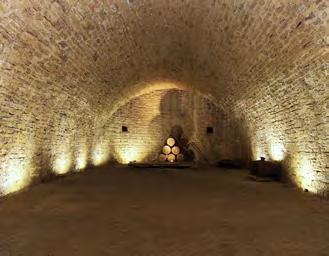


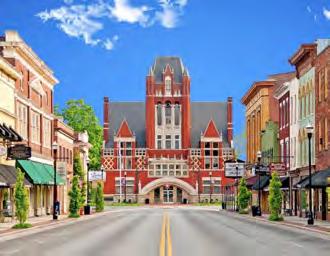

BY EDWARD ODONGO
When summer stretches and is nearing autumn in the Bluegrass State, it’s the optimal time to explore the quieter regions of Kentucky. Beyond the famous horse racing tracks and fried chicken lies a collection of small Kentucky towns rich in history, hospitality and surprise.
From Abraham Lincoln’s hometown to a wine-tasting
experience in one of the country’s oldest bourbon distilleries, these hidden Kentucky gems offer memorable moments and historical narratives worth discovering. Whether you’re learning about the historic trails, traveling the bourbon trails, or exploring the hiking trails, these Kentucky destinations are calling.
Every glass of the amber elixir in Bardstown represents 243 years of bourbon heritage. Named “Most Beautiful Small Town in America” by Rand McNally/USA Today in 2012, Bardstown is a historic treasure rich in character. With a small-town spirit, it has tantalizing Kentucky charm and historic architecture.
Tucked inside the town’s heart are lively taverns, boutique distilleries and museums, making history seem present and close enough to touch. Every visit is a blend of past and present, whether you are dashing into family-owned stops or getting lost in a giant bourbon distillery. Bardstown is the country’s bourbon gem, sitting at the center of Kentucky’s legendary Bourbon Trail. It features more than 10 distillery experiences within a short drive of downtown.
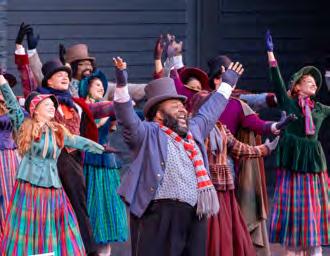
STEPHEN FOSTER STORY THEATER
Experience a slice of Kentucky’s rich musical history
411 East Stephen Foster Avenue
502.348.5971
stephenfoster.com

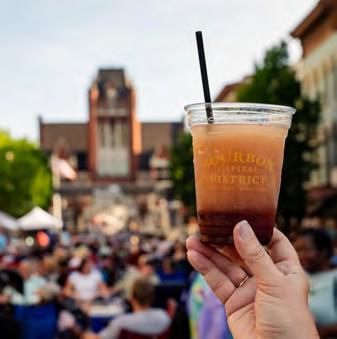

MY OLD KENTUCKY HOME STATE PARK
Historic Federal Hill mansion linked to Stephen Foster’s ballad
501 East Stephen Foster Avenue
502.348.3502
visitmyoldkyhome.com
HEAVEN HILL DISTILLERY BOURBON HERITAGE CENTER
The largest family-owned distillery in the country 1311 Gilkey Run Road
502.337.1000
heavenhilldistillery.com
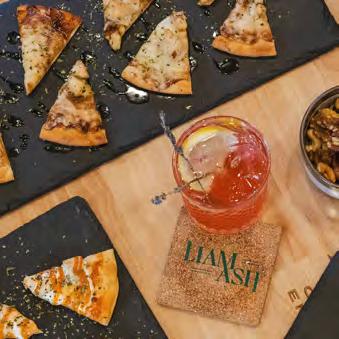
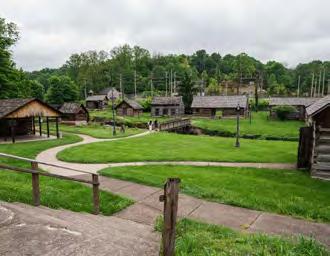
OLD BARDSTOWN VILLAGE AND CIVIL WAR MUSEUM
Kentucky pioneer village highlighting 18th century history and the Civil War
310 East Broadway Street
502.349.0291
civilwarmuseumbardstown.com
Augusta is a scenic community with a backdrop of the Ohio River. The town offers historical intrigue, stunning views and award-winning wineries and features a timeless charm blended with a dash of Hollywood. Augusta was home to legendary singer and actress Rosemary Clooney from 1980 until her 2002 death. Today, it is home to retired journalist and television host Nick Clooney and his wife, Nina, who raised their famous actor-filmmaker son, George Clooney, there. Lucky visitors might spot George in Augusta from time to time visiting his parents. Enjoy wine tasting in the country’s oldest cellars or catch the sunset while riding the Jenny Ann Ferry— one of the few remaining passenger ferries in the area. The highlight of an Augusta trip should be visiting The Rosemary Clooney House, a museum packed with memorabilia from the beloved film White Christmas
MUST-SEE ATTRACTIONS

1811 HISTORIC JAIL
West 2nd Street
606.756.2183
kentuckytourism.com/ explore/1811-historic-jail-521
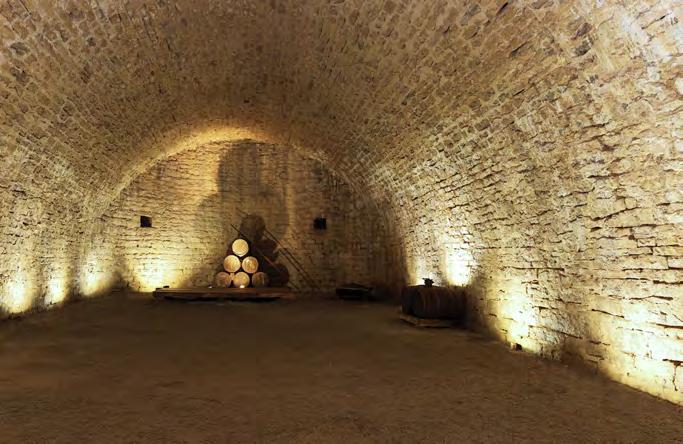
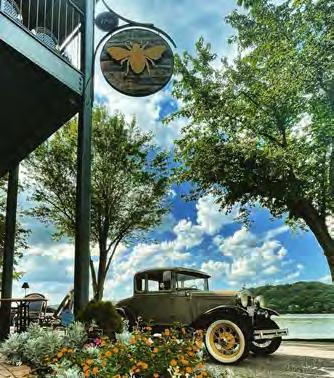
BAKER-BIRD WINERY & DISTILLERY
A wine-tasting experience in a cellar dating back to the 1850s 4465 Augusta Chatham Road
606.756.3739
bakerbirdwinerydistillery.com

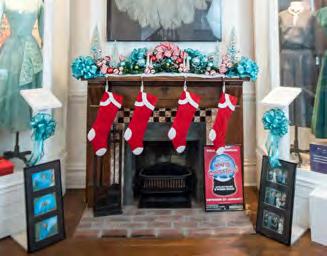
The largest repository of memorabilia and artifacts from the movie White Christmas 106 East Riverside Drive
502.383.9911
rosemaryclooney.org
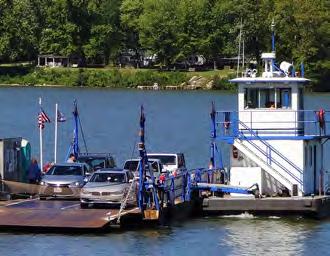
AUGUSTA FERRY
Operating since 1798, it offers unbeatable views of the Ohio River 104 East Riverside Drive augustaky.gov/ferry
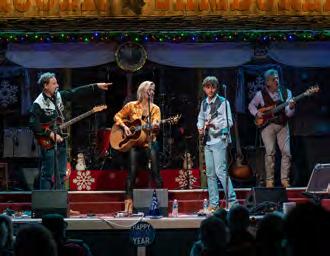
JOEL RAY’S LINCOLN JAMBOREE + RESTAURANT
Experience classic country variety shows
2579 Lincoln Farm Road
270.358.3545
thelincolnjamboree.com

LINCOLN’S BOYHOOD HOME AT KNOB CREEK
Follow the groundbreaking steps of a future president
7120 Bardstown Road
502.549.3741
nps.gov/abli/planyourvisit/ directions.htm

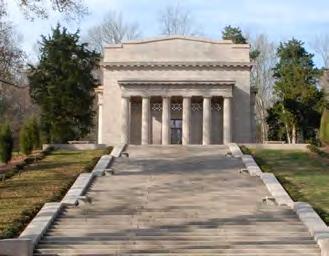
ABRAHAM LINCOLN BIRTHPLACE NATIONAL HISTORICAL PARK
See the Lincoln Memorial Building in which a tiny “Symbolic Birth Cabin” is housed
2995 Lincoln Farm Road
270.358.3137
nps.gov/abli
THE LINCOLN MUSEUM
Enjoy immersive experiences and learn about rare artifacts
66 Lincoln Square
270.358.3163
lincolnmuseum-ky.org
Hodgenville’s identity is tied to Abraham Lincoln, who granted it immense popularity as a tourist destination. The town invites visitors to explore one of America’s most iconic origin stories, starting from the Abraham Lincoln Birthplace National Historical Park. Local legend Laha’s Red Castle has been flipping what many describe as Kentucky’s best burger for 90 years. Don’t miss Joel Ray’s Lincoln Jamboree or the Hodgenville Summer Concert Series. With food trucks, live music, bounce houses and, of course, spectacular fireworks, the Fourth of July is always a mind-blowing experience in Hodgenville. Finally, grab a coffee at Vibe Coffee and sample sweets at The Sweet Shoppe.
For more on Hodgenville, see page 42.

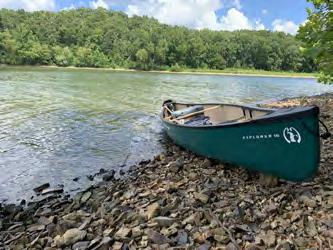

Get your feet wet this summer in the town of Grand Rivers. Whether kayaking across Lake Barkley, hiking forest trails, or casting a line on Kentucky Lake, outdoor excursions remain the main attraction. Local favorite Patti’s 1880’s Settlement is a must-visit locale, not just for its legendary 2-inch pork chops, but also for its Southern flair, whimsical gardens and gift shops. Dive into the Grand Rivers nightlife by heading to The Thirsty Turtle or Between the Lakes Tap House.
MUST-SEE ATTRACTIONS

THE BADGETT PLAYHOUSE
Catch a tribute show or musical revue in a cozy theater
1838 J.H. O’Bryan Avenue
270.362.4224
thebadgettplayhouse.com

PATTI’S 1880’S SETTLEMENT
A distinctive dining and shopping destination
1793 J.H. O’Bryan Avenue
270.362.8844
pattis1880s.com
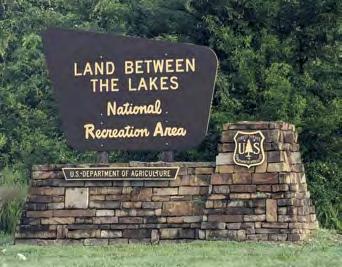
LAND BETWEEN THE LAKES NATIONAL RECREATION AREA
170,000 acres of natural adventure, from planetariums to elk herds
238 Visitor Center Drive
Golden Pond 1.800.525.7077
landbetweenthelakes.us
FUN FACT: It is the only city in the world flanked by two massive dams—Kentucky Dam and Barkley Dam.

KENTUCKY DAM AND VISITOR CENTER
Enjoy scenic lake views as you learn about hydroelectric power
640 Kentucky Dam Road
270.362.4318
tva.com/energy/our-powersystem/hydroelectric/kentucky

Greenville offers a unique charm that features a perfect blend of history and hospitality. Founded in 1799, the Western Kentucky town boasts a beautiful, historic downtown square with a century-old courthouse, inviting cafés and locally owned shops.
Get lost in Brizendine Brothers Nature Park’s tranquil wooded paths. Get your feet wet as you paddle across Lake Malone State Park. Unwind at Sip&Spin Coffee & Records while enjoying some vinyl tunes, or visit the Muhlenberg Community Theatre to catch a local show.
MUST-SEE ATTRACTIONS
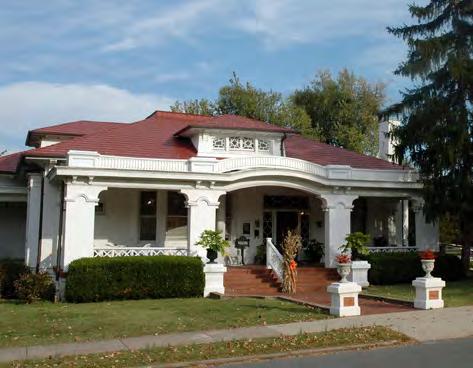
THISTLE COTTAGE
Local history museum and cultural center featuring rotating exhibits
122 South Cherry Street
270.338.4760
muhlenbergarts.org/ thistle-cottage

BRIZENDINE BROTHERS NATURE PARK
Outdoor lovers’ paradise, best for walking, picnics and birdwatching
Chatham Lane
kentuckytourism.com/explore/ brizendine-brothers-naturepark-5360
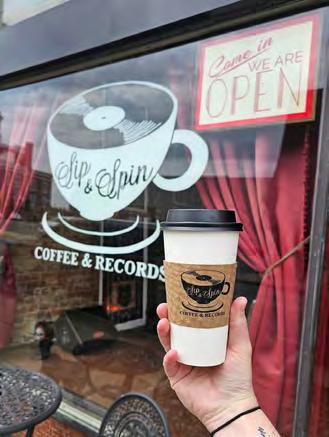
NORTH MAIN STREET HISTORIC DISTRICT
A sampling of late 19th and early 20th century American architecture
199-135 U.S. 62
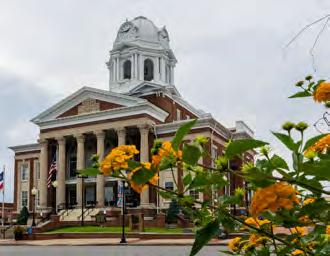
MUHLENBERG COUNTY COURTHOUSE
A neoclassical Kentucky architectural gem
100 South Main Street
270.377.3970
muhlenbergcounty.org
Kentucky’s 121 nursing programs train students to make a difference in the lives of their patients
BY JACKIE HOLLENKAMP BENTLEY
Nursing can be a thankless job—12-hour shifts, cranky patients and less-thandesirable duties we’d rather not put in print. But then there are the countless rewards that go unmentioned.
“You have the best vantage point to make such a difference,” said J oy Pennington, an executive nurse and academic officer with the Kentucky Board of Nursing (KBN). “It’s not just about going in and starting an IV. It’s about showing [patients] care and compassion, a smile and the understanding that you truly do care about them, and that can make all the difference in the world for the family and for the patient. That is an amazing position to be in, as a nurse, to make such a difference.”
Kentucky colleges and universities operated 121 nursing programs, where students can attain these degrees: doctor of nursing practice (DNP), master of science in nursing (MSN), baccalaureate degree in
nursing (BSN), associate degree in nursing (ASN) and practical nursing diploma (PN).
Kelly Jenkins, KBN’s executive director, said the board’s job is to ensure Kentucky’s colleges and universities produce qualified nurses to continue making that difference.
“Kentucky does the best, from my board of nursing employees all the way through all of our programs and the faculty,” Jenkins said. “We have some excellent schools out there.”
Once they have completed a nursing degree, graduates must pass the National Council Licensure Examination (NCLEX).
On average, Kentucky’s nursing programs either have met or exceeded the national average for first-time test takers.
Pennington credited the programs’ faculty.
“They really get involved with the students on a






The Kentucky Board of Nursing protects the public by development and enforcement of state laws governing the safe practice of nurses, dialysis technicians, and licensed certified professional midwives.
LEARN MORE kbn.ky.gov
holistic level, and I think that a lot of your faculty invest heart and soul into those students,” she said. “They know that these individuals are going to take care of them or their family one day, and they take that very seriously.”
Jenkins agreed.
“You can’t have good students who can successfully pass the NCLEX without the great faculty that we have been blessed to have here in Kentucky,” she said. “It’s definitely a calling, because sometimes their students get out of school and they go to a hospital and they make more money from day one than our faculty who taught them how to become a nurse.”
A program occasionally may struggle to reach the board’s NCLEX performance benchmark of 80 percent pass rate, but Pennington said that’s when the board comes in with a proactive approach.
“We’ve changed all of our workshops … that literally show them exactly what we’re looking for and how to do it, and we even give them examples,” Pennington said. “We don’t leave them in the wind to just guess because how can a program succeed if you’re constantly struggling to figure out what to do to make that happen?”
The approach is making a difference. Since 2020, Kentucky’s NCLEX pass rate has ranged from 87.7 percent to 89.6 percent. Q
For a comprehensive look at all of the Commonwealth’s nursing programs, visit the Kentucky Board of Nursing’s website, kbn.ky.gov
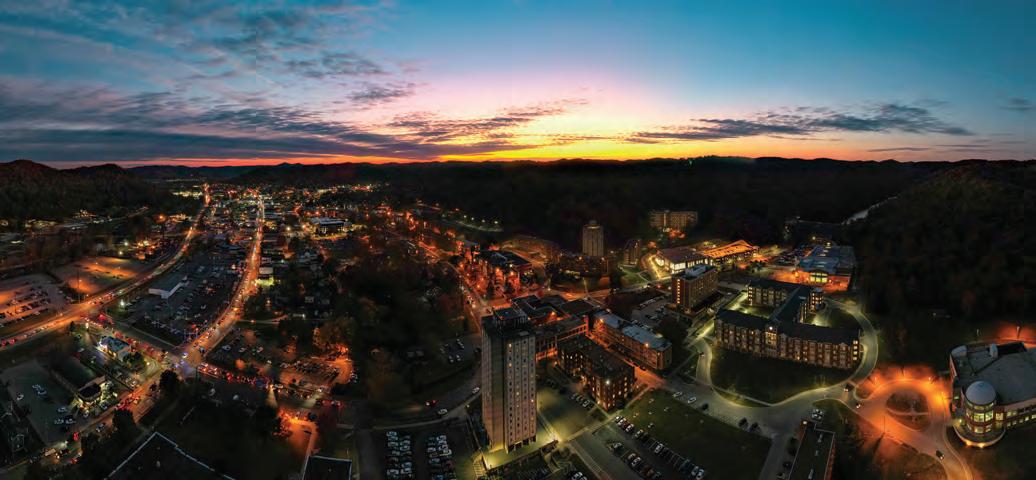

For 60 years, Morehead State University’s WMKY-FM has served listeners in Eastern Kentucky while training generations of students for broadcasting careers
BY JARRETT VAN METER

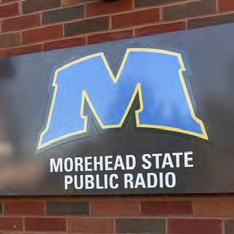

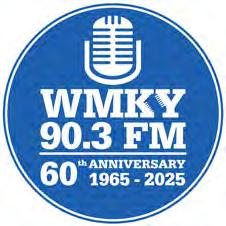

While growing up in Pattersonville, New York, Paul Hitchcock relied on the radio as his vessel for optimism. He listened to Wolfman Jack, Dick Clark and Casey Kasem on his portable AM/FM device and dreamed of being on the other side of the speaker. He longed to connect with an audience in the same manner, wielding clarity, brevity and assuredness. But a large hurdle stood before him: Hitchcock stuttered.
The speech impediment caused him to withdraw. He was shy. He didn’t answer the phone or the door. The radio provided company.
“I remember saying to myself, ‘If I ever get fixed or ever get healed … if they figure out why I can’t talk, I want to be a DJ,’ ” Hitchcock remembers.
He ultimately found relief working with a speech therapist. On his own time, Hitchcock bolstered his growing confidence by pretending to be a radio host. He recorded himself on cassette tapes, asking traditional interview questions to imaginary guests, then borrowing snippets of popular songs to use as the responses. The gag was fresh out of the Rick Dees playbook and served as his first taste of production. He sent the cassettes to his older sister, who was off at college.
Hitchcock’s family moved to Tennessee for his high school years. He chose to attend Kentucky’s Georgetown College “for the sole purpose” of working at the campus radio station, WRVG-FM. He never took a broadcasting class but learned by doing. He served as the station’s music director before becoming the program director. During his senior year at Georgetown and first year out of college, Hitchcock worked professionally for WTKC 1300 in Lexington, then spent a year in Knoxville before moving to Morehead in 1986 to get his master’s degree in communications from Morehead State University. Part of his work-study package was a role as the graduate assistant for sports at the campus radio station, WMKY-FM.
The station’s reputation preceded it. WMKY debuted in 1965 as a four-hour, 10-watt station. Four years later, it became the first station in the country to receive a Department of Health, Education, and Welfare grant to increase its broadcast power to 50,000 watts. In 1980, it became an NPR affiliate station. As Hitchcock walked in on his first day in 1986, he could feel the momentum. All the equipment was new, from the reel-to-reel recorders to the cart machines. Between full-time staff and students, roughly a dozen people buzzed about. The newsroom was active, the Associated Press machine ticking away: duh-duhduhduhduh-duh.
“It was the big time,” Hitchcock remembers.
WMKY, also known as Morehead State Public Radio (MSPR), is licensed to operate at 37,000 watts, according to its website.
Now the general manager, Hitchcock says the station’s secret sauce has been the roughly 1,000 students who have passed through the studio since 1965. Included in that number are all three members of the station’s current core team: Hitchcock, News Director Samantha Morrill and Operations Director Greg Jenkins
On Morrill’s first day as a sophomore in 2013, then-News Director Chuck Mraz handed her a press release from a local hospital about a new clinical service it was rolling out. Mraz told Morrill to write up a “voicer.” Afterward, he sent her into the recording booth to read what she had written.
“I was really shocked,” Morrill remembers. “Day one I was going to get to be on the radio. I was like, ‘This is wild and also very cool.’ I was excited to get in my car later and listen to it, and hear myself on the radio.”
After graduating in 2016, Morrill was hired by WYMT, a commercial television station based in Hazard. Getting internet installed in her Hazard apartment proved to be a lengthy process, during which Morrill resorted to other

means of entertainment. First, she ran through her DVDs of episodes of The X-Files and The Office. Then, she turned on her handheld radio, picking up Richmond’s WEKU-FM. The signal provided an unexpected thrill, and it dawned on her that the experience wasn’t isolated.
“There are people out there who, at any point in time, for whatever reason—they can’t get internet or their electricity is out … they can turn on a radio, and they can pick up a public broadcasting signal and their local NPR station to get news, entertainment, music and weather updates,” Morrill says.
Eventually, Morrill switched back to the medium, first working at WEKU in Richmond before returning to Morehead and WMKY. She was named news director in 2023.
“When you talk about audio, it’s very intimate,” Morrill says. “It’s right there in your ears, getting to experience all of the different stories and content, music, commentary—whatever it may be.”
•
While Hitchcock and Morrill come from broadcasting backgrounds, Jenkins found radio via his interest in music. He first heard WMKY while studying music as an undergraduate at MSU but didn’t begin helping out until he enrolled in a master’s program at the school and landed a graduate assistantship. He left briefly after graduation for
a stint as a high school music and band teacher but returned a few years later when a full-time position came open at WMKY.
Jenkins loves mentoring, learning from, and collaborating with the students.
“We’re producing stuff; we’re having fun doing it; we have deadlines; we have a job to do,” Jenkins says. “We have daily tasks to get done, and everybody on the team is just working together to make those things happen.”
As WMKY celebrates 60 years of public service, one of its principal sources of funding is on the brink. In June, the U.S. House of Representatives narrowly voted in favor of a rescissions package that would eliminate more than $1 billion of previously approved funds for the Corporation for Public Broadcasting, a primary means of support for local stations such as WMKY. As of this writing, it is pending in the Senate.
Despite the ominous cloud cast by the development, Hitchcock hopes people maintain faith in the work that his team, and others like it, do. Radio can serve as an ally to those who need it, as he did when he was a young boy.
“It’s a trusted companion, through good times and bad,” Hitchcock says of radio. “It’s being in touch with your community … They’re talking to you as you listen. It’s a one-on-one communication, and that’s how it should be. It’s making that connection on a one-on-one basis. As humans, we look for that.” Q

by Kentucky Monthly Magazine
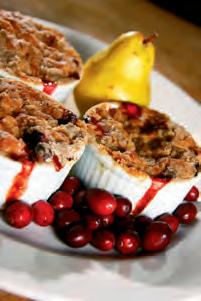
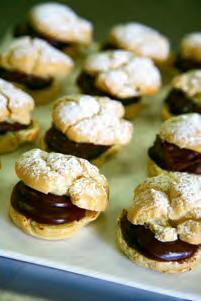

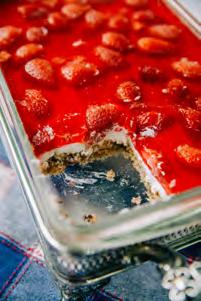



BY GARY P. WEST
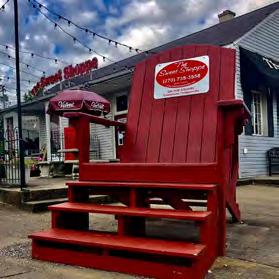
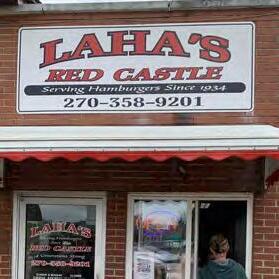

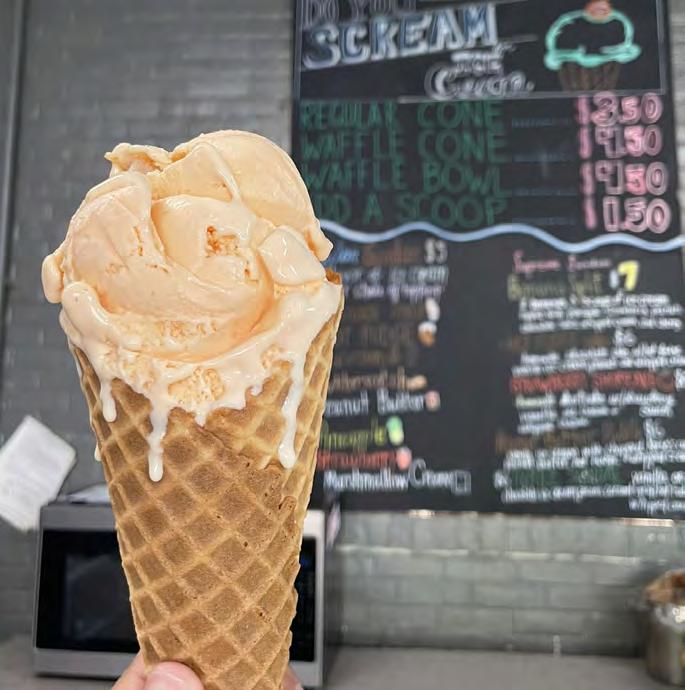
Only a few feet from the Abraham Lincoln statue on the public square in Hodgenville are two notto-miss eateries: The Sweet Shoppe and Laha’s Red Castle. About a half-mile down the road is Joel Ray’s Lincoln Jamboree, another restaurant visitors won’t want to overlook.
There are times when Patrick Durham has flashbacks to some 23 years ago, when his wife, Paula, encouraged him to start making fudge. She had seen her sister doing it and told her husband, “We can do that.”
And did they ever.
Today, The Sweet Shoppe boils up more than 42,000 pounds of fudge a year. Beginning with two kettles in what was a 1940s gas station, they have grown so much that they now have an off-site location to house their

eight double-boiler kettles.
“Each kettle makes 36 pounds of fudge,” Patrick said. “And making as many as 30 different flavors, we needed more space. At one time, we were selling at 50 festivals a year but have scaled back to about 12. Working a festival is demanding.”
This is where the Durhams’ son, Forrest, has joined in. At 27, he’s been around The Sweet Shoppe almost from its beginning.
“I was 6 when I started hanging around [the shop],” he said. “I’m pretty much doing most of it, as Dad has stepped back some. Anybody who has ever made fudge knows there’s a bit of an art to it.”
Patrick smiled when he recalled working at a factory in Elizabethtown, when he didn’t see much of his two kids and Paula, and then he found out that old service station—which, in the interim, was a garden center—might become vacant.
“When I got this spot, it gave me the confidence to think we could make it,” Patrick said. “Tourist after tourist drives by here on the way to Lincoln’s birthplace and on the Bourbon Trail.”
Two years after The Sweet Shoppe’s March 2002 opening, ice cream was added to the chalkboard menu. “We added Blue Bell and Velvet and, believe it or not, it now outsells the fudge,” Patrick said.
The Durhams constantly experiment with new flavors. “We take suggestions and try some of them,” Forrest said. “We have a maple bacon [flavor] and use real bacon we actually fry.”
Peanut butter fudge tops The Sweet Shoppe’s bestseller list. Tiger fudge is close behind. It is a vanilla fudge swirled with melted peanut butter and topped with a drizzle of chocolate fudge. The Durhams also make a Kentucky bourbon-flavored fudge.
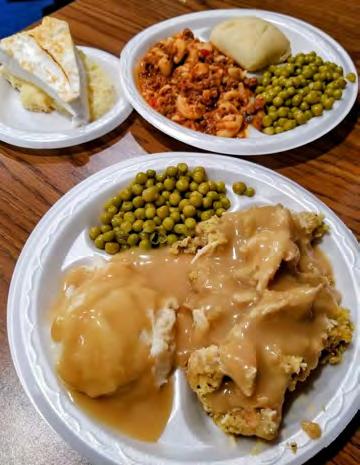
Just when you thought it couldn’t get any better, they have added dessert pastries, along with cookies, brownies, chess bars and Rice Krispie treats.
• • •
Not far from The Sweet Shoppe is an iconic hamburger joint that has been selling its specialty for 91 years. Most who live in and around Hodgenville don’t remember when there wasn’t a Laha’s Red Castle sitting at the corner of the town square, with employees serving up burgers as fast as they could get them off the grill and onto a bun. That’s because Laha’s (pronounced “Layhays”) been at the same location since 1934, when William and Sally Laha started selling hamburgers from a little walk-up downtown. At the time, White Castle was already established, so Red Castle it was.
Today, Ryan Jeffries runs the show. “I’m a fourth generation,” he said. “My mother was a Laha, and I couldn’t wait to be big enough to work here. When I was 10, I was finally tall enough to cook on the grill and smash ’em out.”
That Vulcan grill is the same one that was installed when the present

building opened in the 1950s.
The only seating is 10 counter stools, and the four servers, plus Ryan, glide easily out of the way of each other in the 500-square-foot space.
Food service is classic at Laha’s. The burgers and chili dogs are served on wax paper, and drinks are served in cups or bottles of Coke and Ski. Bowls of chili and fries are popular items.
“We serve about 600 burgers a day, plus 75 to 80 chili dogs,” Jeffries said, as he easily manages up to 40 burgers with onions and cheese on the grill. “Our walk-up window and carryout orders make up 75 percent of our business.”
The word is out on Laha’s. No less than Food & Wine magazine honored its specialty as the best burger in Kentucky in 2021.
“We’ve had customers from South Africa and South Korea,” Jeffries said. “And one lady came in from St. Louis. Said she saw something on TV about us and had a dream about our hamburgers, and the next morning told her husband where they were going to each lunch—Laha’s. She said they drove six hours to get here.”
It’s not unusual for customers to be
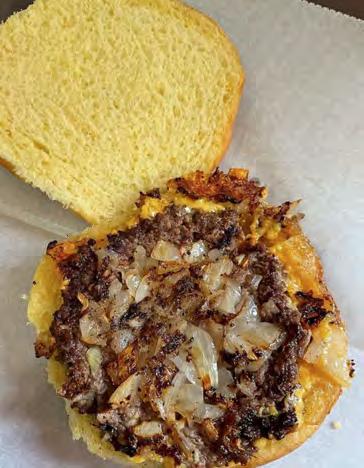
lined up in front of the door before 10 a.m., when the eatery opens.
Tourists come to Hodgenville to visit Lincoln’s birthplace, and quite a few seek a place to eat. Laha’s pops up on an internet search, so the parking spots in the front and rear of the restaurant are occupied primarily by out-of-town cars.
“I’m doing what I always wanted to do,” Jeffries said. “But it’s harder than I thought it would be.” •
Down the road a bit, not far from the Abraham Lincoln Birthplace National Park, is Joel Ray’s Lincoln Jamboree. Even though owner and operator Joel Ray Sprowls died in 2020, the Lincoln Jamboree’s shows and restaurant have stayed the course.
Open since 1954, the Lincoln Jamboree hosts primarily country music acts. The showroom and restaurant recently have been updated. The restaurant serves up country cooking at its finest, including lunch and dinner specials, a Saturday night special and an “oldfashioned Sunday luncheon.” Q
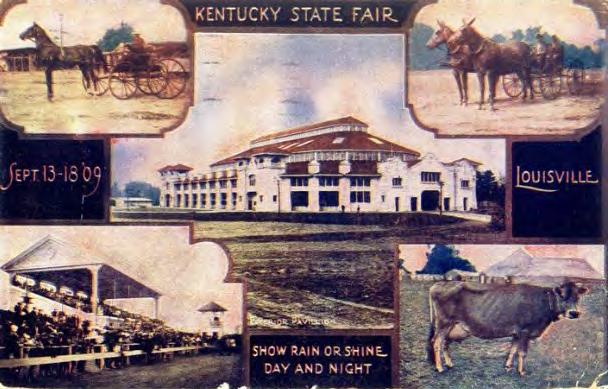
The Kentucky State Fair was established in 1816 by a Fayette County farmer named Colonel Lewis Sanders, who is not known to be relative of Colonel Harland Sanders (actually an Indiana native) of fried chicken fame. The event became our official state fair in 1902. For many years, the fair moved from city to city, but in 1907, Louisville became the fair’s permanent home. This year’s fair takes place Aug.14-24. For more information, visit kystatefair.org
a magazine published for Kentuckians everywhere
Charles Hayes Jr. • Founder
Stephen M. Vest • Publisher
Deborah Kohl Kremer • Editor
Rebecca Redding • Typographist
One-Year Subscription to Kentucky Monthly: $25
Letters to the Kentucky Explorer
Letters may be edited for clarification and brevity.
Someone Lost Their Marbles
I enjoyed “Bully for Marbles” by P.K. Compton in the May issue of Kentucky Explorer. I’d like to share with him that our historic home in Madisonville was East Broadway School in the early 1900s. When we find marbles during our gardening, it thrills us. Some look very old and different.
Deb Allen, Madisonville
Abbreviations to Use to Find 50 Percent More Ancestors in Newspaper Articles
n Use an abbreviation instead of a full word.
n Typesetters used abbreviations to save space
n Enter the abbreviation in your search criteria
n Find hidden articles
Els for Elizabeth Wm for William Corp for Corporation
NYC for New York City
Jos for Joseph Margt for Margaret Saml for Samuel Deb for Deborah
Hy for Henry
My for Mary Agt for Agent
Ag for Agnes
Capt for Captain Co for Company
Pres for President Col for Colonel Chas for Charles
Benj for Benjamin Cpl for Corporal
Geo for George Robt for Robert Thos for Thomas
Genl for General Danl for Daniel Pvt for Private Theo for Theodore CPO for Chief Petty Officer
Courtesy of Kenneth Marks, The Ancestor Hunt, theancestorhunt.com.

FOUNDED 1986, VOLUME 40, NO. 6
Kentucky Explorer appears inside each issue of Kentucky Monthly magazine. Subscriptions can be purchased online at shopkentuckymonthly.com or by calling 1.888.329.0053.
In memory of Donna Jean Hayes, 1948-2019
Virginia was owned by England until after the Revolutionary War. Kentucky was owned by Virginia until it became a state on June 1, 1792.
1743—Frederick County, Virginia, was created. 1757—Loudon County, Virginia, was formed from Fairfax County, Virginia.
1770—Botetourt County, Virginia, was formed from Augusta County, Virginia.
1772—Fincastle County was created from part of Botetourt County.
1776—The United States declared its independence from Great Britain on July 4. It became a sovereign nation on Jan. 14, 1784.
1777—Montgomery, Washington and Kentucky counties were created from Fincastle County, which was abolished Dec. 31, 1776.
1780—Lincoln, Fayette and Jefferson counties were formed from Kentucky County.
1785—Nelson County was formed.
1786—Bourbon, Mercer and Madison counties were formed.
1789—Mason and Woodford counties were formed.
1792—Kentucky became a state with those counties mentioned above.
1792-1912—The remainder of the 120 counties were formed. The last one established was McCreary County on March 12, 1912.
Compiled primarily from An Historical Atlas of Kentucky and Her Counties by Wendell H. Rone Sr. This was part of the 1815-1965 Daviess County Sesquicentennial Edition.
By Paul Vaughn, Hopkinsville
The Southern Appalachian Mountains of Eastern Kentucky are a rugged and diverse mountain range. They are considered to be a temperate rainforest. During certain times of the year, the foliage will drip with water as if it had rained all night.
According to mountain lore, when the foliage drips extra large amounts of water, they are weeping for a Kentucky champion who has died. On Nov. 22, 2001, Dr. Adron Doran died, and the mountains wept. Truly, Adron Doran was a champion for the Commonwealth of Kentucky.
I first heard of Doran when I was a student at Maysville High School. At that time, he was president of Morehead State University. Articles about the university and the many changes taking place during that time of growth under Doran often appeared in the local newspaper, The Ledger Independent. It was during this time that Maysville High School re-established its football program through the work of Dr. James Tenery and Tom Browning of Browning Manufacturing. The equipment for this program was generously donated by Morehead State University.
Morehead grew from a small teachers’ college to a major university and stands as a respected educational institution in Eastern Kentucky because of the foundation laid by Doran.
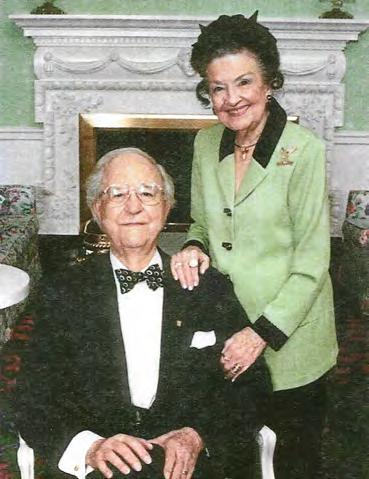
Doran was a student of Restoration church history. He co-authored The Christian Scholar: A Biography of Hall Laurie Calhoun with J.E. Choate and, in 1997, he wrote a book titled Restoring New Testament Christianity. During his life, Doran wrote numerous articles on the Restoration Movement that will aid students of Restoration history for many years to come.
Doran was elected to the Kentucky House of Representatives in 1943 and served as speaker of the House in 1950. Many people viewed his educational achievements or his political efforts as the most important events in his life. However, he viewed his work as a Gospel preacher as more important than anything else. He faithfully preached the Gospel for many years in the churches of Christ.
Adron Doran was born on Sept. 1, 1909, in Western Kentucky in a three-room tenant house in Graves County. His father was Edward Conway Doran, and his mother was Mary Elizabeth (Clemons) Doran. Adron graduated from Cuba High School in Graves County. His first introduction to higher education was at Free-Hardeman College in Henderson, Tennessee. After receiving his Associate of Arts degree, he entered Murray State University, where he earned bachelor of science and master of arts degrees. He then entered the University of Kentucky, from which he graduated with a doctor of education degree. Doran’s progression as an educator spanned 45 years. His first work in education was as a high school teacher, principal and coach before becoming president of Morehead State University, where he served for 23 years (1954-77).
Doran accomplished many things in his life, but one could not have met him without recognizing that he viewed his marriage to Mignon as second only to his service to God. Doran married Mignon Louise McClain on Aug. 23, 1931. His love for his wife was one of the greatest lessons the students at Morehead State University could have learned during his time as president. He valued family as more important than even being a president of a university.
I will relate one example of the love this couple had for each other. Doran was invited to deliver a series of lessons on the New Testament at the Jackson Church of Christ in Jackson (Breathitt County). Just before the lectures, Mignon became ill. He did not want to leave her behind, and she did not want him to cancel the lectures. So she went with him but stayed in the motel while he delivered the lectures. As soon as each lesson was over, he rushed to the motel to see how his beloved wife was doing.
In his life, Doran was a great encourager to young people. He certainly was to me. He is greatly missed! The mountains were not the only things that wept at his passing.
Send memories to Deborah Kohl Kremer at deb@kentuckymonthly.com or mail to Kentucky Monthly, Attn: Deb Kremer, P.O. Box 559, Frankfort, KY 40602.
“I
By Peggy Patterson Mull, Louisville
In the 1940s, we lived far out in the country. There was no electricity or running water, but we children didn’t know that was a problem at the time! I was about 10 years old and my brother and sister were 6 and 2 when we were allowed to go berry picking with our mother.
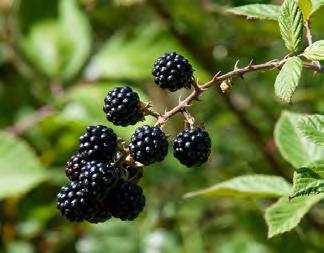
She waited for a nice warm, sunny day in August, when the berries were at their peak. That day, she explained to us that we each would have a onequart bucket that we could fill with the fattest ripe berries we could find. First, though, we could eat as many as we wanted. When our stomachs were full, then we were to start picking in earnest. She told us our fingers would be stained with the juice along with the old clothes we wore, and that the stain would not wash off—it had to wear off—but we didn’t care. We were warned to watch for snakes because rattlers and copperheads were known to be in the area and loved to sun themselves wherever they found a patch of sunlight. If we ever smelled watermelon, we were to freeze in place and call her so that she could locate the snake and get us away safely. People in the area swore that the smell of watermelon was a sure sign a poisonous snake was nearby. Luckily, we never smelled watermelon or saw a snake, probably because three noisy children might have been enough to cause any snake within a mile to slither quickly and quietly away well in advance of our arrival.
When our buckets were filled with berries, they were emptied into one of my mother’s two 1-gallon buckets. When those were full, it was time to go home. Berry picking usually took a whole morning, and the afternoon was for making the jam.
In the dirt yard by the house, there was a permanent fire site. Three stacks of stones were piled about 12 inches high to allow for a wood fire under the washtub, where water was heated. The galvanized aluminum washtub was always hanging on a nail on the wall outside the house and taken down only to sterilize canning jars and for use on wash day.
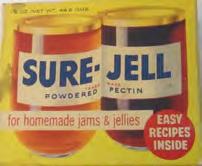
Kindling was first placed under the tub, then lit. As it caught fire, larger pieces of wood were added so that a good fire was going. Water was drawn from a dug well close by using a winch to draw it up in a gallon bucket. The tub was filled about three-fourths full and heated to boiling. It was my 6-year-old brother’s job to make sure the fire was fed and kept going. The wood had been chopped by my father and stacked near the house for use both inside and outside. Ten to 12 pint jars were loaded into a wire rack, lowered into the boiling water, and left there for about 30 minutes. While the jars were being sterilized, my mother took the berries into the kitchen and looked through them to remove any bugs, sticks, bad berries or the occasional green berry that had slipped in. She rinsed them in cold water and placed them in a large pot that sat on the wood cookstove. There was no written recipe; my mother had learned from her mother how much sugar and Sure-Jell had to be added. The Sure-Jell was something containing gelatin that caused the jam to hold its shape. Otherwise, it would have been too runny or loose. Enough water was added to the pot so the berries cooked but did not burn. When they were cooked down to the proper consistency, the jam could be put into the sterilized jars and sealed with melted paraffin to keep it from molding. The jars were filled to within an inch of the top to leave room for the paraffin.
The paraffin was melted in an old 3-pound lard can used just for this purpose. Only a small amount could be melted at a time, since paraffin is highly flammable, and you couldn’t take a chance on an accident when you lived miles out in the country. Approximately a half-inch of paraffin was poured on top of each jar of jam. The jars were then placed on a 2-by-4 inch board, which was part of the wall in the house.
Nothing tasted as good as that homemade blackberry jam, seeds and all, on a homemade biscuit!
By Edwin Hall, Kennesaw, Georgia
The old guy had gray hair, a mean face and a paunch. His St. Louis Cardinals uniform looked official, but it was one or two sizes too small. There was no doubt he was in charge of the proceedings, and we huddled around home plate listening to his every word. There were about 30 of us boys, ranging in age from high school to college. Some wore baseball uniforms, but most of us were attired in some colorful combination of jeans and T-shirts. All were eager to show off our baseball skills at this St. Louis Cardinals tryout camp at Browning Ball Park in Harlan in the hot summer of 1959.
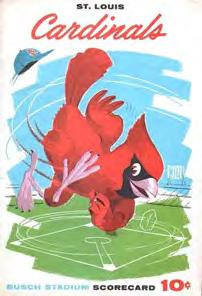
It was the summer I turned 17 and was set to start my senior year at Cumberland High School. My cousin, Jack; three or four other boys from Cumberland, Benham and Lynch; and I had piled into a car and journeyed the 22 miles to Harlan to attend. I knew all these boys and had played various sports with them and/or against them. My best sport was basketball, then came football, then baseball, a distant third. The passengers in the car that day were good baseball players, including Jack, and all of them were better than I was, but who was I to pass up an experience like
By Carol Ingle, Scott County
Momma, who was a teen at the time, was up early on that Saturday morning in 1943. Although my mother hardly ever was allowed in the kitchen, my granny was going to teach her to bake for the pie social that afternoon. All the boys who lived in the area would be there. The teacher held up the pie and told who baked it. Then the pie went to the highest bidder. The winner of the pie got to sit with the girl who had baked it and eat the pie with her.
this, even if I was only along for the ride?
Mr. Paunchy Cardinal Scout divided us into units by positions—infield, outfield, catcher, pitcher, etc.—and we began a modified version of a baseball game, with wholesale substituting of players after each inning. The scout stood behind home plate and grunted a few positive comments about Jack’s infield work and ditto for couple of the boys from Lynch. An older boy from Benham with a strong outfield arm drew some interest. I got to work out at first base with one of the infield units and threw a ball to the catcher that was wide enough off the mark to make the scout dodge out of the way. To this day, I’m not sure if that wild throw was an accident or on purpose. Anyway, the camp ended without my getting a chance to bat, and the grouch thanked us all for attending. Then we piled back into the car and headed home. There was plenty of conversation on the ride back about who were the best prospects at the camp and whether anybody merited some follow-up from the Cardinals. I harbored no hopes of a Major League Baseball career and was not even bummed out about not getting a chance to bat that day, but I can tell my grandchildren and anyone else who will listen that I once had a tryout with the St. Louis Cardinals … well, sort of.

My momma had a young man in mind. She had her fingers crossed that he would get the money to bid on her pie. But Momma moaned and whined because she did not know the first thing about baking.
Granny helped her make the crust first. She got out her bowl and told Momma to wash her hands, fill the bowl halfway up with flour, then get a little bit of lard. Mom asked, “How much is a little bit?” Granny told her about half the size of an egg. Mom got the lard. Granny told her to squeeze the flour and lard together until crumbly. Next, they added water a little at a time until the dough could be rolled out. Then, they baked it until lightly brown. Granny
supervised, and the crust was completed. Then they got started on making a filling. Since Momma loved chocolate, they were going to make a chocolate cream pie.
Momma put the dry ingredients into a big cast-iron skillet. She added the remaining ingredients, set the skillet on the heat, and stirred until thick. When the filling got thick, Momma put it on top of the crust. She was so proud.
To make meringue for the top of the pie, Momma had to separate the egg yolks of three eggs. Granny told her to make sure not to pop the egg yolk, as it would ruin the whites if any yolk got in them.
Before making the topping, Momma was going to scrape the pan and eat the filling. She scraped the pan, then shoved the spoon in her mouth. As soon as she took a big bite, she ran to the trash can spitting out chocolate and gagging. She said, “It’s the worst pie I ever tasted!”
Granny stuck her finger in the pan and tasted. Momma had used salt instead of sugar. They had to start all over.
They managed to get the pie baked and made it to the social. The boy Momma liked bid on the pie and won. A year later, they got married, and two years after that, they had me
By Robert Zwicker, Richmond, Virginia
Abraham Lincoln once said, “ All the armies of Europe and Asia … could not by force take a drink from the Ohio River … in the trial of a thousand years.”
There was a time in the 1950s when a small group of us boys from the School of Our Lady in Louisville took on the responsibility of watching for those foreign armies. We controlled a fairly large section of the river bank near Our Lady’s, bounded by the floodwall, the K&I Bridge and Shawnee Golf Course, including more than a half-mile of shoreline. We patrolled our subject area faithfully and spent days and sometimes nights roaming the woodlands, the forests of giant ragweed, the sandbars and the river bank of our domain, unchallenged by foreign armies or other kids. We caught snakes and lizards, and tried endlessly to catch fish without much luck. There was a solid sandbar near the center of our riverbank stretch where we were allowed to have overnight fishing expeditions. In the early days of our reign, we were well supplied with sodas and sandwiches from home and lit our campsite with smudge pots borrowed from the city. When we reached our middle teens, we found a way to add cans of beer to our supply of nutrients.
The gars and skipjacks that infested the local waters were impossible for us to catch, and without a boat, we had no access to the productive fishing areas, so we made do with the occasional small chubs or, surprisingly, goldfish (known locally as Chinese carp). These were actually large enough for a patient person to eat, but we never did, as we had no taste for the fish that was described by local cynics as “sewer bass.” Our lack of fishing success didn’t much change our overall experience. In fact, serious fishing probably would have interfered with our main goals of exploration and adventure.

Our Lady class of 1954, including all founding and occasional members of the riverbank defense force. The author is in the back row, second from left, next to the priest.
display of the river’s bounty—mostly large catfish, with a mixture of other fish and turtles thrown in. This was the most dangerous of our riverbank protection responsibilities, as the fishermen were highly agitated when they discovered our work.
In the autumn and winter, we lit our campfire with dried ragweed, which gave off an odor that is impossible to forget. It was only years later that I was shocked to learn that the smell of burning ragweed is indistinguishable from the smell of burning marijuana. (Here I must quote Bill Clinton’s famous line: “I didn’t inhale!”)
In those days, the K&I Bridge was a grated roadway through which you could see the river below. At one point in our adventures, we found two young men below the bridge with .22 rifles shooting up at pigeons in the rafters, apparently unconcerned about the obvious possibility of puncturing a gas tank, oil pan or cyclist.

But there was a time when our fishing experience was much more interesting. Professional fishermen occasionally placed their huge hoop nets along our stretch of the river. We, of course, considered it our duty to inspect these, and what we found when we dragged the nets on the shore was an amazing
As the bridge was the boundary of the area of our responsibility, we did not challenge them.
Our reign over this domain was brief, as we suffered the same tragic end that befalls all kids—we grew up. I’d like to think that new young heroes have taken over responsibility for our river section, but this probably isn’t the case. The function of our peaceful playground has been savagely and permanently disrupted by the construction of Interstate 64 through that area. Our personal parkland is now just a fading memory for a few of us.
By Clifford W. Dowell Jr., Louisville
Breckinridge County

The United States Army Corps of Engineers began construction of Lock and Dam #45 on the Ohio River in 1922 after buying large amounts of land in Brecki nridge County. The lock and d am was completed for boat traffic in 1927, making the little town of Addison, which by then included two grocery stores and a post office, a booming community.
I grew up on my grandfather Otis Dowell’s farm Alta Vista just east of Addison in the 1940s and ’50s. I can remember the government reservation, which consisted of 10 houses with modern conveniences that were built for the workers on the navigation dam. All of us neighboring farm children played with the children of the dam workers. Most of us went to school in a two-room school at Holt’s Bottom for six years, and then we were bused to the middle school or high school in Hardinsburg.
Both the river and the dam played an important part in our family’s life.
When my father’s family members were gathered around the supper table, they occasionally could hear the calliope playing on The Delta Queen. The music could be heard as the showboat came from the Stephensport bend of the Ohio River. The family jumped in the car and went down to the lock and d am to listen to the music and see the boat lock through the dam before it turned the Addison bend of the river and continued its cruise.
During World War II, young men were drafted and volunteered for the a rmed s ervices. The war seemed to be far away, although people could see newsreels of battles at the movies. Tragedy struck when a neighbor’s young son, Jimmy Stephens, was killed in France . The war came to be real overnight, and the Ohio river seemed to have a lot more boat traffic.
This steam locomotive is pictured chugging past the just-constructed brick Consol company bakery house beside the tracks in Jenkins (Letcher County) in May 1913.
The bakery provided retail bread and baked goods to Jenkins and the surrounding areas of McRoberts, Dunham, East Jenkins and Burdine.
The building still stands today and houses The American Legion.
Neighbors watched as the first Landing Ship Tank, or LST, locked through the dam. Our family was proud, knowing that my father, Clifford Dowell, contributed to the war effort by helping to build the LSTs at the “boat works” in Jeffersonville, Indiana, across from Louisville. They were concerned because they knew the boat was going to the Pacific Theater of war, where my uncle, Paul Moorman, served as a Marine. Later, we learned my Uncle Paul and other Marines with their gear were packed into an LST and sent on a wild voyage on the Pacific Ocean from Hawaii to the island of Guam.
The postmistress at Addison, Mrs. Mae Harpe, tirelessly made sure that families received their mail from their loved ones who were stationed overseas. When battles were long and hard, letters did not arrive
Our family was no exception, and we waited for mail to arrive The unit of my Aunt Mildred’s husband, Johnny Waznuck, was pinned down by heavy Nazi fire in a pillbox for 32 days. Of course, there was no mail or word at home for a month. Mrs. Harpe made every effort to get letters from servicemen to their families, often meeting the families in their cars after dark. She sent word to families when letters came in and stayed late when mail trains were delayed. When the siege was finally lifted, mail from the soldiers came in bunches, much to the delight of their loved ones.
Unfortunately for the little town of Addison, all good things had to come to an end. In 1971, Dam # 45 was blown out and was replaced by a bigger and better dam some 17 miles downriver, just upstream from Canneltown, Indiana, and Hawesville, Kentucky.
About all that is left for a lot of us is the memory of a small town, the people that used to be there, and how things used to be.

By Jessica K. Whitehead
In the mid-1920s, newly returned from an illuminating stint studying art in New York City, an aspiring painter named Harlan Hubbard (1900-1988) sought his unique creative voice in the steep hills and quiet waterways of his native Northern Kentucky. Following the advice of other artists he admired— like Frenchman Claude Monet or fellow Ohio River Valley visionaries such as John Henry Twachtman—Hubbard found inspiration in what Asher Brown Durand called “the studio of Nature.”

“I must work with real materials, the earth and sky, sun and wind,” Hubbard wrote in the 1930s, “[…] I must not paint through a window, but out in the sun and rain.” His words echo the exhortation made by Monet in
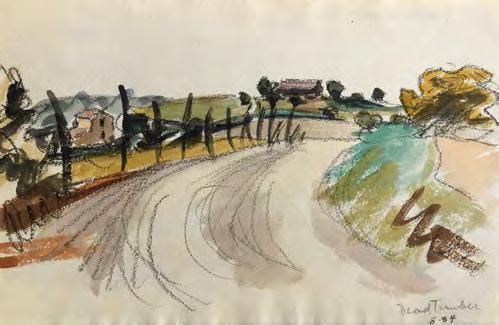
the 1870s, while gesturing at the river Seine: “I don’t understand why anyone would want to shut themselves up in some room. That’s my studio.”
Where Monet had the Seine and the sea to inspire him, Hubbard had the Ohio River. He established “studios” for painting in bankside camps shielded by willows or in his hand-built canoe. Hubbard took his portable thumb box everywhere, loaded with alizarin red, cadmium orange, yellow ochre and phthalo blue, using river water to mix pigments and create watercolor sketches en plein air
When he wasn’t on the river, he rambled on foot or on his bicycle—over
Three Mile Road, Dead Timber Road and Winter’s Lane in the countryside near Fort Thomas, Bellevue and Covington—in all seasons. Capturing the diffuse light of

winter in the snow-covered highlands or recording the verdant hollers folding on either side of the country roads winding back down toward the river, Hubbard made hundreds of sketches on his pilgrimages, immersing himself in the landscape he called home—his personal wilderness.
Plenty of artists who preceded Hubbard—such as Lewis Henry Meakin, Paul Sawyier and Thomas Jefferson “T.J.” Willison—saw the value of Kentucky’s quiet charm for landscape painting. But Hubbard is, perhaps, one of the most ardent recorders of Kentucky’s natural landscape. His grasp of the Ohio River’s unique genius loci—spirit of place—is evident in the hundreds of immediate sketches he made in nature over the course of his life—sketches filled with the river and the surrounding countryside, shown in all moods and weather.
Hubbard’s sketches in watercolor, like Monet’s rough color-blocking studies made on his canvases, were done swiftly in the elements, capturing impressions of color and light for posterity. They are emotive, even expressionistic: Hubbard deploys line and color with a frenzied and free gestural quality that betrays his passion for what he sees. We know from the vigor of his hand that we are witness to the fruits of inspiration.
Hubbard also shows us his working mind in the studies. Through them, we know the essential elements he needed to record in order to understand and remember a particular land or riverscape. Sometimes just a few lines—a horizon or a rippling reflection of sun on water or a string of steam rising from a boat’s stack—are enough to preserve the freshness of the scene for later.
Even though Hubbard believed, like Monet, that the best studio an artist could find was outdoors, Hubbard still curated indoor spaces in which to create his finished work. (Incidentally, Monet did, too.) Hubbard maintained
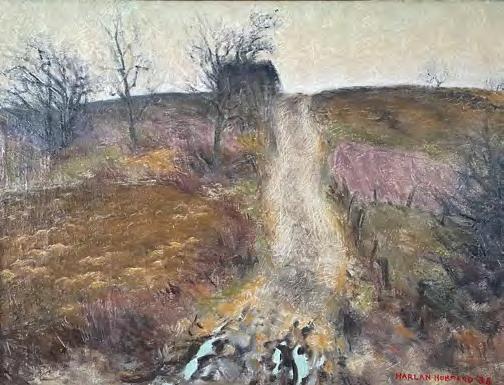
four different structural art studios in Northern Kentucky between 1925 and 1944. In these more traditional studio spaces, Hubbard took his sketches and translated them into more finished works in oil or acrylic on canvas or Masonite.
Despite being created under a roof instead of under a canopy of trees, Hubbard’s finished paintings still honor the experience of being alive to nature and the spirit of place. We recognize it in a blossoming redbud set against a backdrop of distant blue-green hills, or in the silver riffles of river water against the shoreline that then flatten and stretch into a darkened mirror on their way to the opposite bank, or in the scrubby rise of a steep dirt path to a dark barn silhouetted against the horizon. The raw emotion of his sketches becomes somewhat subdued when he exits the “studio of Nature,” but his genuine love for his subject—for the land he knew so well—is never lost.
Fundamentally, Hubbard believed that the Ohio River Valley deserved to be rendered with the same devotion as other, more dramatic landscapes of America. In a letter to The Cincinnati Enquirer submitted in 1933, Hubbard wrote, “In gathering material and studying the country, I have covered much of it on foot, and travelled up and down the river in all sorts of boats, sketching its hills and bends, towns, boats and people. To me, it is beautiful country and worthy of great art.”
Jessica K. Whitehead is the author of the new biography Driftwood: The Life of Harlan Hubbard and served as a founding board member of the nonprofit organization Payne Hollow on the Ohio.


By Sam Terry, Glasgow
The first newspaper published west of the Allegheny Mountains and in Kentucky made its debut on Aug. 11, 1787. When Kentucky was a territory of Virginia, those living in pioneer towns found their issues were neither highly regarded nor understood by papers hundreds of miles away in cities such as Richmond, Baltimore or Philadelphia. In the 1780s, Lexington was a small but growing town of 300 settlers living in fewer than 50 log cabins. As the desire for Kentucky to become a state became the top issue, brothers John and Fielding Bradford decided Kentucky needed a newspaper. There were no experienced editors or equipment to be found, so the brothers traveled east to purchase a press and learn some basic information about publishing a newspaper.

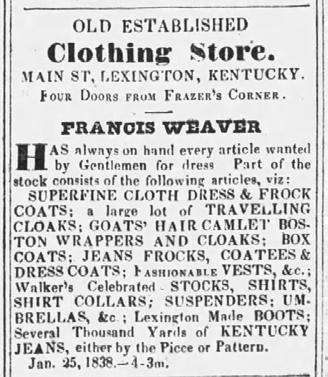

The Kentucke Gazette published its first issue five years before statehood was achieved. History generally credits John Bradford as the founder, since Fielding left the frontier in 1788, but the initial effort was the work of both men. The early editions were small—two pages—but in time, the size was increased to four pages, and it was published weekly. News from the East Coast and foreign countries kept frontiersmen informed, but the balance of copy was local news of interest to those living on the frontier.
Clippings from the newspaper.
In its initial year, John had 180 subscribers—more than half the population of Lexington—who paid 18 shillings per year. If cash payment wasn’t possible, Bradford announced that he accepted “corn, wheat, country-made linen, linsey, sugar, whiskey, ash flooring and cured bacon” as payment.
By March 1789, John had changed the name to The Kentucky Gazette with the now-traditional spelling of Kentucky after the Virginia General Assembly officially changed the spelling. John also printed the first book published in Kentucky, a compilation of the first session of
the Kentucky legislature in 1792 shortly after Kentucky became the nation’s 15th state. By 1809, the newspaper had grown to a six-page weekly, and John’s son, Daniel Bradford, having taken over his father’s enterprise, boasted that his newspaper was “superior in size to any weekly paper in the United States and equaled by but few daily papers.”
For just over two years in the late 1820s, John returned as publisher, producing some of the most important work documenting early Kentucky history in 66 columns entitled “Notes on Kentucky.”
Originally published on Facebook: Sam Terry’s Kentucky and samterryskentucky.com Sept. 5, 1809 Feb. 18, 1838
Outside of his work as Kentucky’s first publisher, John left an indelible mark on the state and the city of Lexington. As chairman of the Transylvania University Board of Trustees, he was responsible for recruiting Rev. Horace Holley as the school’s president, establishing the institution as one of the leading colleges in America. A tireless entrepreneur and promoter of education and culture, John helped to establish Lexington as the famed “Athens of the West” with involvement in virtually every aspect of life in that city.
Daniel sold The Kentucky Gazette in 1840 to Joshua Cunningham, an experienced newspaper editor from Maryland. Unfortunately, Cunningham’s failing health resulted in the demise of Kentucky’s first newspaper after 61 years, with its final edition on Dec. 29, 1848.
A few copies of the first iteration of The Kentucky Gazette remain, with the Lexington Public Library holding the largest collection of original copies but not the first edition of Aug. 11, 1787. The last documented first issue was in the Cheapside office of H. Howard Gratz when it burned decades ago. Gratz had resurrected The Kentucky Gazette after the Civil War, continuing in business for nearly 50 years.
Kentucky History and Genealogy Conference 2025 Kenton County Public Library in Erlanger, Aug 8-9. For more information, visit kentonlibrary. org/genealogy/historyconference.
Kentucky Shakespeare Festival C. Douglas Ramey Amphitheater, Central Park in Historic Old Louisville through Aug 10. Check website for dates and times. Free. For more information, call 502.574.9900 or visit kyshakespeare.com
Developing Trail of Tears Interpretation at Land Between the Lakes McCracken County Public Library in Paducah, Aug 28. Free. For more information, call 270.442.2510 or visit mclib.net.
Kentucky Documentary Photographic Project The Frazier History Museum in Louisville. Through Nov. 9. For more information, call 502.753.5663 or visit fraziermuseum.org.
Reach 120,000 readers with a classified ad in Kentucky Explorer! Classified ads are only $50 per issue (up to 25 words). Contact Deborah Kohl Kremer at deb@ kentuckymonthly.com or call 888.329.0053.
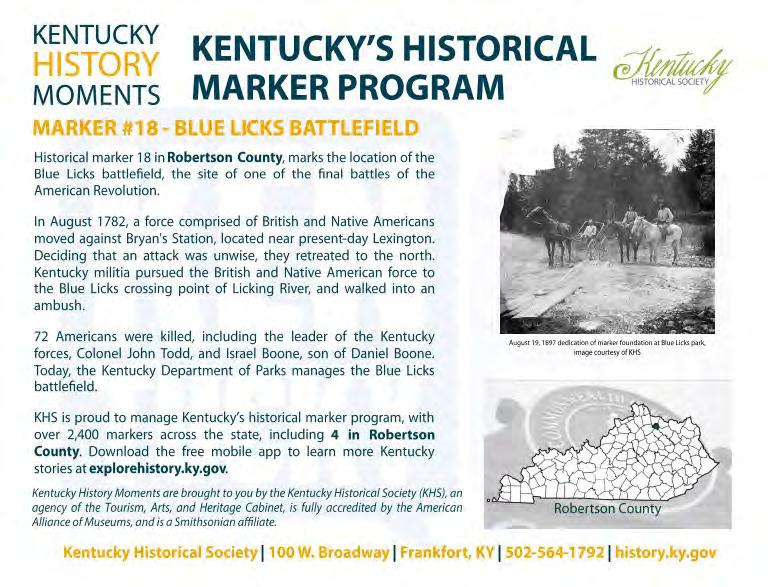
ANTIQUES & VINTAGE MARKET
Lawrenceburg Fairgrounds, 351 E Eads Pkwy., Lawrenceburg, Indiana. The first Sunday of the month MayOct, next show Aug. 3, 6 am-3 pm. Over 200 dealers. 513.702.2680, lawrenceburgantiqueshow.com. (M-O)
KENTUCKY ANTIQUE TRAIL — Trail brochure/maps are in Kentucky state welcome centers and member stores. Visit KentuckyAntiqueTrail.com. Contact info@AntiqueTrail.com or call 256.797.5640.
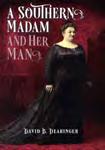
BOOK FOR SALE — Belle Brezing was not the only game in town! A Southern Madam and Her Man tells the fascinating story of Lexington’s other successful madam of the Gilded Age. It is beautifully illustrated and indexed and includes a list of Lexington’s madams of the period. At Black Swan Books, Lexington and Amazon.com. (JJ)
BOOK FOR SALE — A Kentucky Boy With No Sense: An Old Judge Recounts His Boyhood Misadventures in Franklin, Kentucky by William Robey Harris Jr. Available on Amazon. com (print $12; digital $5) or by calling 270.776.7855.

BOOK FOR SALE —
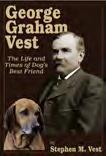
George Graham Vest: The Life and Times of Dog’s Best Friend chronicles the life and career of Frankfort native, jurist and legislator George Graham Vest. The book is by Stephen M. Vest, a cousin, who is known for his command of the English language. $26.95 plus shipping. To purchase, call 888.329.0053 or visit shopkentuckymonthly.com
BOOK FOR SALE —

Reflections of a Scared Soldier Boy in Vietnam: God, Redlegs, and Blueboys by Robert Adams. My combat tour with the First Air Cav Division. 859.806.5199. (A-A)
WANTED Paying cash for large diamonds; collections of vintage wrist and pocket watches; gold and silver coins; sterling flatware and serving pieces; gold and silver jewelry; collections of arts and crafts and pottery; antique advertising signs; antique walking canes; pocket knives; collections of antique guns and swords; military collections; early hand-crafted crocks and jugs; musical instruments. Call Clarence, buyer for more than 35 years; 606.531.0467. (F-D)
BOOK FOR SALE —

Highlighting rural Kentucky events from 1880, this adventurous story by C.W. Shumate waited 145 years to be shared. Butler Books available at cwshumate.com (M-D)

For most, losing one’s father is sad. For a 9-year-old, having a father die in a foreign land and not understanding the circumstances can leave lifetime scars.
For Lexington resident James B. Wells, losing his father Jack Wells, an Army veteran working in foreign services in 1965 Vietnam, became an obsession leading to Because: A CIA Coverup & a Son’s Odyssey to Find the Father He Never Knew
The investigation started after Wells discovered 400 letters his father had written to his mother.
Wells writes of his investigation, including trips to Vietnam and interviews with scores of people. And he claims that he found evidence that the CIA and American government covered up the incident involving his father’s demise.
He finds admirable insights about his father—and, as former Kentucky Poet Laureate Richard Taylor stated, has unearthed “the spiritual truths that bind a son to his father, a husband to his wife … [and] revitalizes his faith, gaining an understanding of a deeper spiritual wisdom that transcends cultures.”
By Steve Flairty
Because: A CIA Coverup & a Son’s Odyssey to Find the Father He Never Knew, by James B. Wells, Milspeak Books, $25.99 (H)
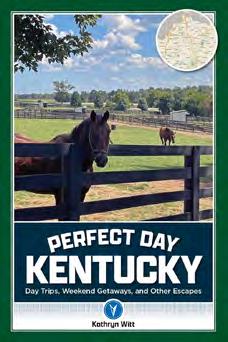
Kathryn Witt’s Perfect Day Kentucky: Day Trips, Weekend Getaways, and Other Escapes is a well-written, practical guide for your next visit to most any fun spot in the Bluegrass State. The author has done homework and provides colorful photos, compelling maps and an inviting narrative that makes a trip through the book almost as fun as seeing Kentucky’s travel spots.
A longtime writer, Witt has published seven books. Perfect Day Kentucky features areas across the state, showcasing tidbits of their history with historic sites. She includes restaurants, parks, shopping venues, arts and entertainments spots, and detailed contact information. For many Kentuckians—even well-traveled ones—the book may provide newfound excitement about traveling in the state.
In Perfect Day Kentucky, Witt hopes to put “the quintessential experiences before you, while presenting additional suggestions to inspire further exploration and encourage longer stays.”
Witt lives in Northern Kentucky.
By Steve Flairty
Perfect Day Kentucky:

As horrendously bloody as the large battles of the American Civil War were, much blood was shed in smaller skirmishes around the country in guerilla warfare. One state that suffered the onslaught was Kentucky.
Meade County author Gerald W. Fischer follows up to his first book on the subject with Guerilla Warfare in Civil War Kentucky, Volume II: Legacy of the Irregulars
Highlighting the parts that Kentucky communities such as Bloomfield, Cynthiana, Brandenburg and Shelbyville played—along with profiling violent characters such as William Quantrill, Ed Terrell and “Sue” Mundy—Fischer provides illuminating narratives and includes a detailed timeline (1837-1866), which shares individual guerilla’s backgrounds and general events involving them.
Though Fischer mentions that 92 percent of the men fighting for the South had no slaves, he titles his last chapter, “The Civil War Was About Slavery.”
By Steve Flairty
Acclaim Press, $26.95 (H)
Earlier this summer, I made a three-day sojourn to northwest Tennessee’s Reelfoot Lake, an earthquake-born, cypress-studded natural waterway that hugs the Mississippi River. Unique in its origins and for two centuries a lodestone for rod and gun pursuits, today Reelfoot floods around 15,000 acres but is only, on average, about 5½ feet deep. Tennessee claims most of the waters, but a small slice of this historic lake spills into Kentucky. The two states also share the 10,428-acre Reelfoot National Wildlife Refuge.
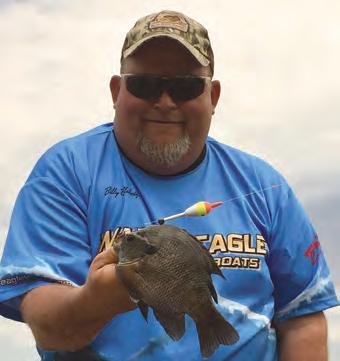
I’d planned to meet Alan Clemons, a longtime friend and editorial colleague. We were in pursuit of some of the lake’s famed saucer-size bluegill, which, with veteran guide Billy Blakley, we found in abundance (photographic evidence of which can be seen at theoutdoornotebook.net).
On our first morning on the water, however, we teamed with crappie specialist Jeff Riddle, who—under a cloudless sky and on a windless, hot morning—gave us a PhD-level lesson in using forward-facing sonar. The electronics took some getting used to and reminded me somewhat of fishing via video game, but it was impressive in its accuracy and efficiency, evidenced by the double-digit crappie that regularly popped up on the screen and usually took a bait that was dropped near them.
We joined Billy the next day, which dawned overcast and surprisingly cool. The challenge of Reelfoot never changes: Every spot looks fishy. Billy guided us past a lone cypress crowned by an osprey nest and through a patch of lily pads larger than a football field to the edge of a stand of flooded cypress. For bluegill, Billy is a cricket-under-abobber man. It’s Fishing 101. Simple and pure fun. I had brought along a fly rod and a box of poppers but soon abandoned it for a bait and bobber rig, my fly-casting skills not being equal to the challenge of fishing in and around stands of century-old cypress trees.
By the time a late-morning thunderstorm chased us back to the dock, we had filled a cooler with tasty, hard-fighting, hand-size (and bigger) bluegill for which the lake is known.
It was a comfortable, relaxed morning. Alan, Billy and I have been fishing together since we all had dark hair. We worked out of Blue Bank Resort (bluebankresort.com), a fifth-generation fishing and hunting camp that has evolved into a full-service facility tooled equally for sportsmen,
sportswomen and non-consumptive visitors alike. It’s a business model that might be useful to other outfitters.
Due to a recent wave of storms and flooding, the outer section of the dock was under repair. A couple of guys stood in chest-deep water driving posts into the mud. Billy idled past them and nosed his War Eagle boat gently against the dock. A deckhand appeared, secured a bow line and offered a hand to the departing fishermen, which Alan and I both ignored, and which I almost immediately regretted after the boat rocked, and I clumsily caught a toe on the dock and stumbled, resulting, fortunately, in no damaged tackle.
This is a silly thing men do—declining a helping hand when one is graciously offered—a result, I suspect, of the ugly combination of stubbornness, pride and ego.
That evening, during dinner with the resort owners— brothers Michael and Drew Hayes—Alan and I reviewed the morning and our respective media visits to Reelfoot.
“When I first came here on assignment, I was younger than you are now,” I said to the 31-year-old Drew. “Nearly 40 years ago, I guess.”
The confession resulted in raised eyebrows.
“How old are you?” Michael asked. “If you don’t mind.”
“Don’t mind at all,” I said. “I’ll be 70 in a few weeks.”
On the walk back to the cabin, we stopped to chat with a guy fishing from the dock. Within a couple of minutes, he landed one fish and lost another.
“Drew and Michael seemed surprised that you’re so old,” Alan, who sometimes confesses to being “semi-retired,” said with a smile. “Ever think about quitting?”
I glanced out at the lake, which appeared flat as a fitted sheet under the bright moon. I’ve spent most of my working life in places like Reelfoot, some so far off the beaten path there were reachable only by paddle or horseback. I am thankful for this. I’ve never given much thought about age, although its effects, annoying though they might be, are undeniable.
“No. Not really,” I said. “We’re aging outdoors. I can’t stop one and don’t want to stop the other. Do you?”
“Never.”
Readers may contact Gary Garth at editor@kentuckymonthly.com
BY BILL ELLIS
First, let me express my gratitude to all the people who grow, harvest, process and furnish me with the food I need and eat every day.
My grandfathers Ellis and Stratton were farmers. I recall quite vividly how in the 1940s and ’50s agriculture in my little part of the world revolved around the family farm.
I remember what it was like to work in a tobacco patch—sowing a plant bed, pulling the plants, plowing, planting by hand or by machine, worming, suckering, cutting, housing, and on and on. The work followed the seasons. I recall listening to a University of Kentucky men’s basketball game while pulling tips in a cold stripping room, with Owensboro’s Cliff Hagan leading the way to another victory.
The work followed the seasons.
I can’t say I ever enjoyed any of the above and was glad when Pop gave up our small crop and concentrated on building houses. Most of all, I loved the old welding shop and the people who brought work there.
•
• •
I began working at Pop’s east Shelbyville welding shop part time in the summer of 1952. He paid me a dollar a day the few days I worked. Otherwise, I was free to roam as boys were allowed to in those days. My job that first day was to finish welding an old horse-drawn cultivator that Pop had cut down and spot-welded to fit a three-point tractor hitch. As he always said, “I’ll show you once, and you’ll always know how.”
I bet that right now I can still weld
a straight bead. Pop said I was really good when a piece of light machinery had to be brazed. I almost cried when my wife, Charlotte, and I moved from our old house in Richmond to a condo in Lexington, and I had to give up my little Lincoln arc welder.
I fondly recall the farm people who frequented the “shop.” Almost all were kindly, hard-working folk. Some of the men wore long-johns well into the summer. Word had it they did not bathe often. Some of them smelled that way. You got used to it.
There were brothers who worked the land, and sometimes their sister kept house for them. One hot day, the smaller of the two brothers, overheated by the sun, began to pass out. I caught him in my arms before he fell to the shop’s concrete floor and laid him gently in the shade. I drew cold water on a clean old rag and bathed his face. I bought him a Coke from our machine. His brother stood by and appeared shaken. From then on, every time the smaller man came into the shop, he wanted to buy me a Coke. I wish I could recall his name. They were the “salt of the earth.” I recall hearing back then that sometimes tenants were abused by the land owners.
From what I see on TV, factory farms now produce most of the hogs, chickens, turkeys, cattle and vegetables we buy in the supermarkets. I know there are still middle-sized and small farms around. I can never pass up a roadside market.
I wonder about the state of agriculture in Kentucky. From what I
read and hear, the number of farmers nationwide decrease as the size of farms increase. Many farmers across the country are struggling. The same is true for Kentucky.
Information sent to me from the University of Kentucky’s MartinGatton College of Agriculture, Food and Environment in February stated: “Kentucky farmers face uncertainty in 2025, with grain farmers possibly facing struggles under low prices. However, livestock producers could benefit from strong cattle markets.”
“Increased tariffs” could raise concerns for farmers.
Ominously, the reports read: “The average farm’s working capital ratio, a key measure of liquidity, is eroding.”
By the time this article is published, I wonder if this forecast came true. Are the usual combinations of markets (foreign and domestic), weather, tariffs, wars and rumors thereof giving Kentucky farm families constant headaches?
While traveling across America out West and even up into Canada as far as Newfoundland and Labrador in the last couple of years, I have been disheartened by the number of abandoned houses, barns and fields.
Particularly on the backroads and side streets of small towns, they seem to multiply with each trip. Recently, on roads near Tyler, Texas, where our daughter and her family live, I saw the same thing. Abandoned houses, closed storefronts and an old gas station were boarded up along the old highway.
Has everyone moved to the bigger towns and cities? Did the folks living
there move away? Was this their last home? Did they die there?
You still see cattle on farmland as you drive down the interstates and main highways, but you never see hogs, much less smell them.
As a kid, I recall that about every farm in Shelby County had hogs. One time, while fishing in a farm pond, a large hog wiggled under a fence and, unbeknownst to me, gobbled up freshly caught bream I had carelessly thrown behind me on the bank.
I seem to be rambling on, don’t I? These are the thoughts of an old man who misses the old days.
Do we still have the old family farm I grew up with? Family-size farmers, please tell about your lives. What do you raise? Are you a “row cropper?” I once met a row cropper from Western Kentucky who said he raised 1,600
acres of corn, 1,600 acres of wheat, and 1,600 acres of soybeans.
All the old family dairy farms have just about disappeared. Notice the old dairy barns and silos that appear to be about to collapse? My last welding job was to weld together the metal flooring in a Harvestore silo on a hot Saturday morning in the early 1970s, not long before Pop sold his business.
When we lived in Richmond, I raised a home garden as well as a plot on Eastern Kentucky University farmland. As I worked my way up the ranks, we needed the food. I miss my two asparagus beds, a patch of rhubarb—originally taken from my Grandmother Ellis’ garden—and a small red potato plot.
Driving along country roads in some places, the scene has been

plots that once were farmland. Most of these folks don’t appear to have gardens anymore.
I reckon I should be impressed by it all. It all seems so tranquil, prosperous. We won’t need that farmland anymore, what with factory farms and imports!
Charlotte and I now live in a condo nestled in Lexington. We have no yard, no garden, no grass to mow. I should feel lucky to be a fairly prosperous retiree living on teacher’s retirement and Social Security.
Maybe the old song now holds truer than ever.
“Ain’t a-gonna need this house no longer, ain’t a-gonna need this house no more … I’m gettin’ ready to meet the saints.”
Readers may contact Bill Ellis at editor@
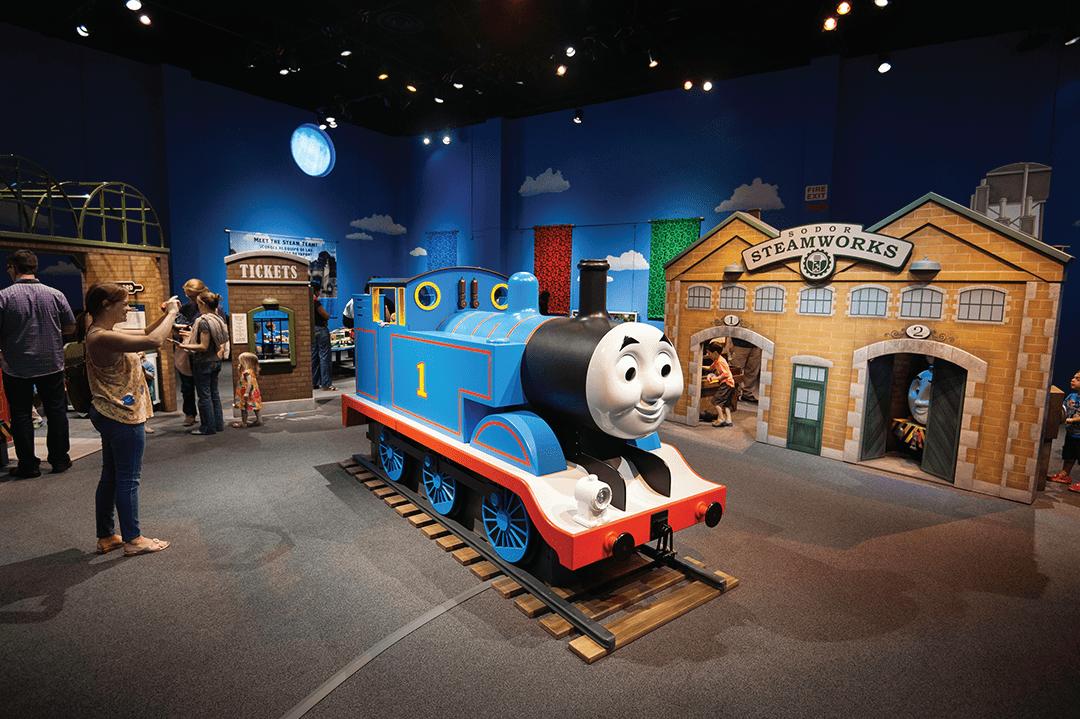


BY WALT REICHERT

August is the month for answering the gardening questions that come in during the year. But before we get to the questions and answers, let’s look at a couple of gardening chores best done in August:
n August is a good month to dig and divide German bearded iris. Your iris bed will bloom better with thinning every three or four years. Discard rhizomes that have holes in them or are mushy.
n Lawn renovation is best done from the middle of this month until the end of September. It is critical, though, to keep new seedlings watered.
n Keep an eye out for aphids, scale and mites on evergreens. They thrive in hot, dry weather and can damage plants quickly. Check with your local Extension office if you’re not sure what these pests and their damage looks like.
Now to the Questions
Q. Moles are destroying my garden. What can I do to get rid of them?
A. Contrary to popular belief, moles do not eat plants. They are
carnivores, eating worms, grubs and other soil insects. In many ways, they are helping the garden by eliminating grubs and other bad guys. Their tunneling also aerates the soil. The damage they do, if any, is in uprooting new seedlings and small plants. Do not fall for the products claiming to get rid of moles, such as Dawn dish soap, solar-powered vibrating gizmos and marshmallows. The best way to get rid of moles is to use special mole traps inserted into their runs. You can also buy poisoned “gummy worms” and place them in the runs, but be careful that your pets can’t dig them up and ingest them. Products containing castor oil are said to be somewhat effective.
Q. I’m confused about gardening zones. What zone am I, and what does that mean?
A. The USDA has divided the country into gardening zones based on temperature, last- and firstexpected frost, and so on. There are 10 zones, with 10 being the subtropics of Florida, Texas, etc., and 1 being the tundra regions of Alaska and Canada. Those 10 zones are further divided into two sections, A and B, with A
being the more northern section of the zone and B being the more southerly section. Most of Kentucky is in zone 6B, while the northern portions are in zone 6A. Far Western Kentucky falls into zone 7A. Use that information to look up the dates of the first- and last-expected frosts in your area. But remember: Those numbers are just averages. For example, in my zone (right on the edge of 6A/6B), the frost-free date is May 10, but a few years ago, we had frost on May 10-11. So use hardiness zones as a guide, but keep your eyes on the skies.
Q. What is the best grass for Kentucky lawns?
A. The University of Kentucky recommends turf-type tall fescue. Note: That is not the same as Kentucky 31 fescue, which is more suitable to pastures.
Q. I was driving through New England, and the homes there have beautiful blue hydrangeas in front of their porches. I want some. How do I make hydrangeas?
A. Hydrangeas will be blue or pink (if they aren’t the white varieties) depending upon soil acidity or alkalinity. Acidic soils, like those in most of New England, will produce blue flowers; alkaline soils will produce pink flowers. I would recommend getting your soil tested at your local Extension office and note the pH of the soil. If the soil is pH 7 or above, you are going to get pink flowers, not blue. If the soil test shows a pH of 5 or 6, you can add aluminum sulfate or sulfur to the soil around the hydrangea to lower the pH to get blue flowers. Plan to add
the amendments every year because your soil will revert to its natural state.
Q. I’m hoping to put in a perennial garden that is attractive to pollinators. What are some easy-to-grow perennials that also attract pollinators?
A. Lots of perennials, especially native perennials, attract pollinators, and most are easy to grow. Let me suggest five native perennials that will give you something blooming for most, if not all, of the gardening season:
Amsonia – Also called bluestar, amsonia will bloom in early- to midspring. It’s a hardy plant that also exhibits fine, bright yellow fall color and is attractive to honeybees and other pollinators.
Baptisia – Also called false indigo, baptisia blooms in colors ranging from yellow to light blue to deep blue, almost purple. Baptisia is attractive to bumblebees and sports interesting seed pods that last through the winter.

Monarda – Also called bee balm, monarda may be the single best pollinator-attracting plant in the garden. Bees, wasps and hummingbirds are attracted to its early-summer blooms. ‘Jacob Cline’ is a tall monarda that is a hummingbird magnet.
Mountain mint – Mountain mint is not a particularly showy plant, but when it blooms in mid- to late summer, it will be covered with pollinating flies, honeybees and wasps. The plant is also hardy and not bothered by pests.
Native asters – Asters will bloom in late summer through fall and round out the gardening season. Blooms of purple, white and yellow will be attractive to pollinators when not much else is in flower. Be sure to plant asters in soil that drains well or they won’t survive more than one season.
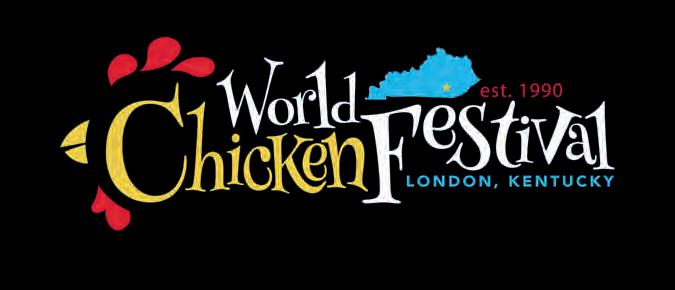


Readers may contact Walt Reichert at editor@kentuckymonthly.com







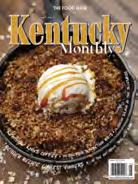
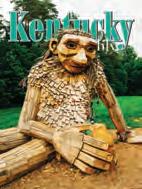

Bluegrass Music Hall of Fame, Owensboro, through March 28, 270.926.7891
Photographing Western Kentucky Museum, Bowling Green, through Dec. 20, 270.745.2592
Flea in the Fort Tower Park, Fort Thomas, 859.572.1209 The Monarchs Concert My Old Kentucky Home State Park, Bardstown, 502.348.5971
Car Cruise
Waveland State Historic Site, Lexington, 859.272.3611
Victoria Findlay Wolfe
National Quilt Museum, Paducah, through Sept. 9, 270.442.8856
Tea Tuesday
Waveland State Historic Site, Lexington, also Aug. 12, 19 and 26, 859.272.3611
Dinopalooza Louisville Zoo, through Sept. 1, 502.459.2181

National Quilt Museum, Paducah, through Oct. 7, 270.442.8856
downtown Corbin, through Aug. 9, 606.528.6390
Adkins Paramount Arts Center, Ashland, 606.324.0007
Four Old Broads on the High Seas Barn Lot Theater, Edmonton, through Aug. 9, 270.432.2276 Picnic with the Pops “Back to the ’80s,” The Meadow at Keene Barn, Lexington, 859.233.4226
Paws on the Patio Moonsong Bar and Café, Tempo by Hilton, Louisville, 502.576.4646 Good Rockin’ Tonight! Pioneer Playhouse, Danville, through Aug. 16, 859.236.2747
Kentucky State Fair Kentucky Exposition Center, Louisville, through Aug. 24, 502.367.5000
Woodland Art Fair
Woodland Park, Lexington, through Aug. 17, 859.246.7024
Burlington Antique Show
Boone County Fair Grounds, Burlington, 513.922.6847
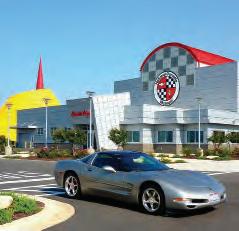
Del McCoury Band Lexington Opera House, Lexington, 859.233.3535 Hollywood’s Golden Moments Orchestra Kentucky, SKyPAC, Bowling Green, 270.904.1880
Slay: The Night Shift Tour Mountain Arts Center, Prestonsburg, 606.886.2623
Tyrone Dunn & Kin-Folk Live Plaza Theatre, Glasgow, 270.361.2101

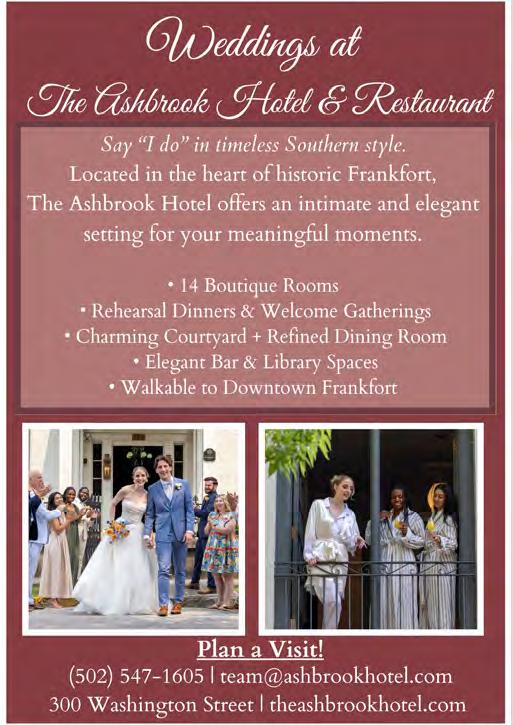
NSCDA-KY
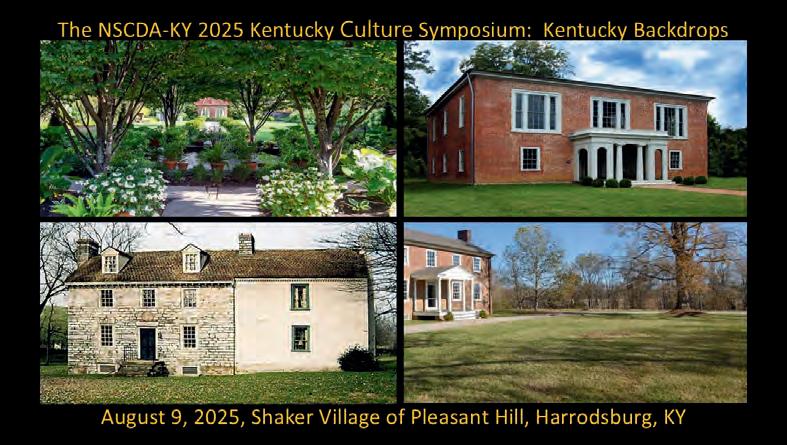


Dr. William T. Luckey Jr. is the Commonwealth’s longest-serving college president, having assumed the top post at Lindsey Wilson College in 1998. Luckey has spent nearly his entire career on a campus that faintly resembles the one he first joined in 1983— 42 years ago this month.
When Bill Luckey went to work in the Lindsey Wilson admissions office, the Columbia institution had 362 students and 16 faculty members. Circle those numbers: 362 students and 16 faculty members. Most Kentucky high schools were larger— much larger. LWC’s total assets were less than $4 million and, unknown to the Louisville native and Saint Xavier High School graduate, the college was on the brink of closure.

total campus population when Luckey first arrived.
“I can’t get over how many people are here,” said Trustee Carrie Luker Farris, one of the featured speakers. “It’s overwhelming.”
The signs were everywhere. The basketball floor was warped. The books in the library were molding. But nobody told him times were bad.

“I fell in love with Lindsey Wilson from the moment I arrived on campus, and that love and admiration have only grown exponentially,” he said. So has everything else.
As you can guess, the school did not close, and on July 1, LWC became Lindsey Wilson University. To illustrate its growth, when the name change officially was unveiled at an invitation-only reception at Louisville’s J.B. Speed Art Museum, the exclusive guest list exceeded the
That’s understandable. When Farris, a member of the Class of 1967, began her freshman year, Lindsey Wilson was a two-year school, offering classes to “preachers and teachers.”
“At Lindsey, I found my footing, my confidence, that no matter what career I chose, I could succeed,” said Farris, of Versailles, who enjoyed a successful career in education, public relations and clinical research. “This means a lot to me personally, not only because I have been a part of the growth and development of Lindsey Wilson College to Lindsey Wilson University. With each new advance, I can visualize our commitment to our mission growing stronger.”
Today, LWU has more than 4,100 students, and in 2024, LWC awarded 1,780 degrees across 28 majors and five graduate programs. The full-time
faculty has grown from 16 to 120. In 1983, LWC fielded a baseball team that often had to push its bus to get it started and offered men’s and women’s basketball. That was it. Today, the university has 29 varsity athletic teams and more than 120 team and individual national championships.
Luckey said that, while he never allowed himself to imagine LWC closing, he also never envisioned it becoming a university. “Actually, I was one of those who fought the name change,” he said. “Being a university was never a goal. Our only goal has been to provide the richest and the warmest possible environment for our students and faculty to excel.”
While much of the school’s growth has occurred during Luckey’s time on campus, part of that, he insists, is happenstance. “It has only gotten stronger in the 42 years I’ve been here,” he said. “I didn’t create it; it was here long before I arrived”—pointing to several examples, including John B. Begley, who served as president from 1977-97 and was one of Luckey’s mentors.
Founded in 1903, the school has weathered two world wars, two global pandemics and the Great Depression. “We’ve always understood, no matter the obstacles— and there have been obstacles—no matter the challenge, there must be movement, there must be work, there must be progress,” Luckey said. “And when all else fails, fake it until you make it.”
I’d say they’ve made it.



